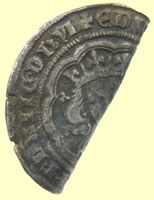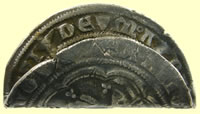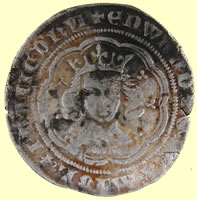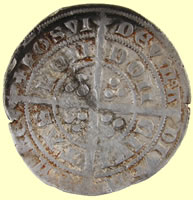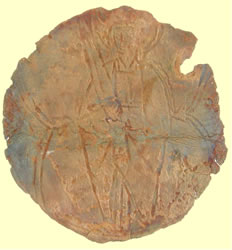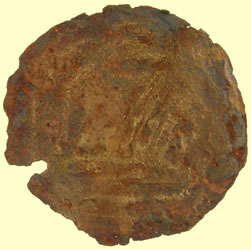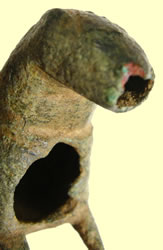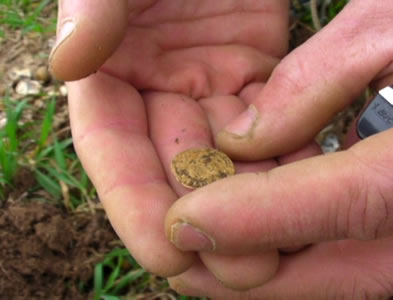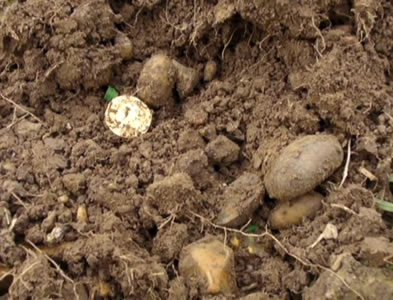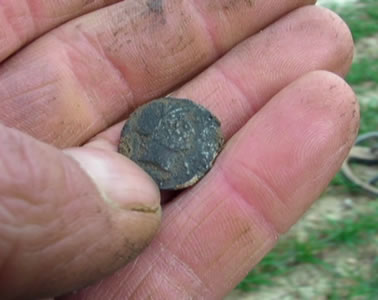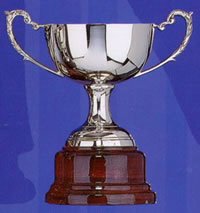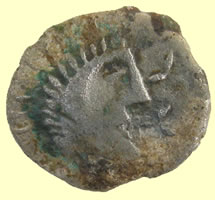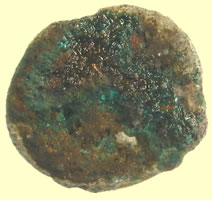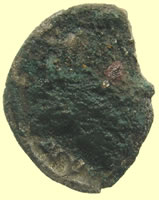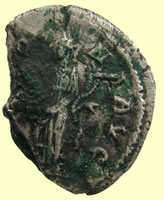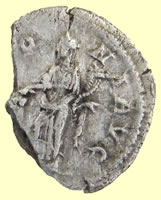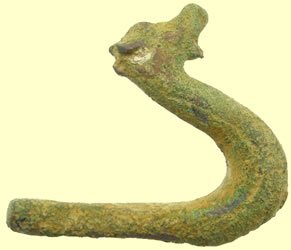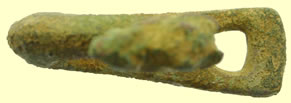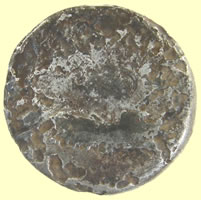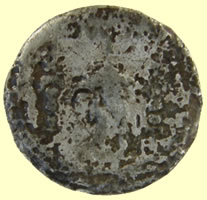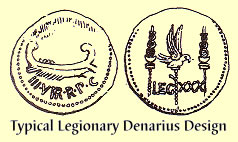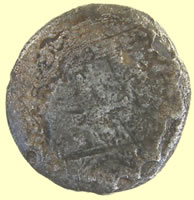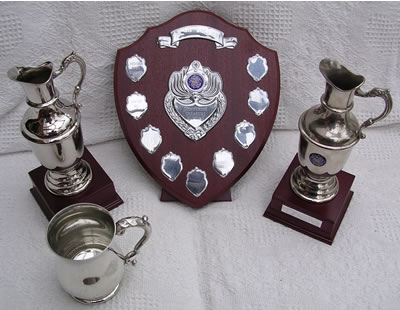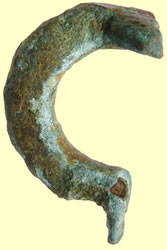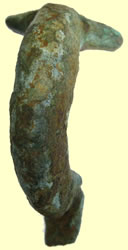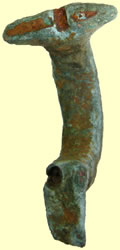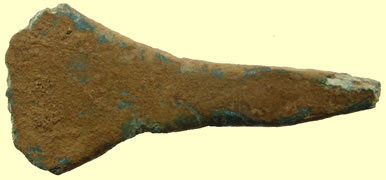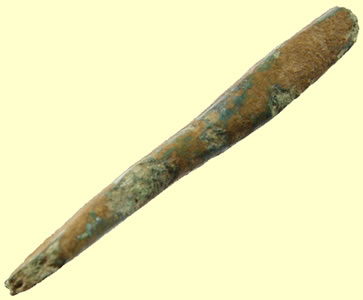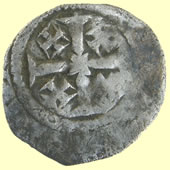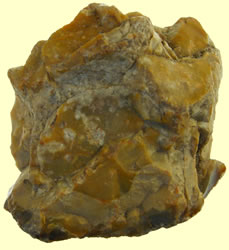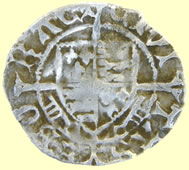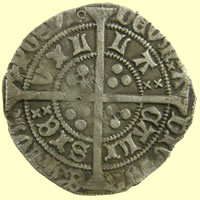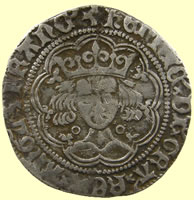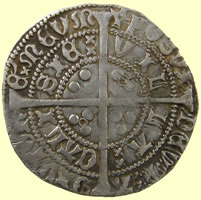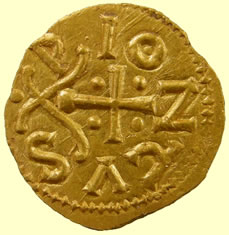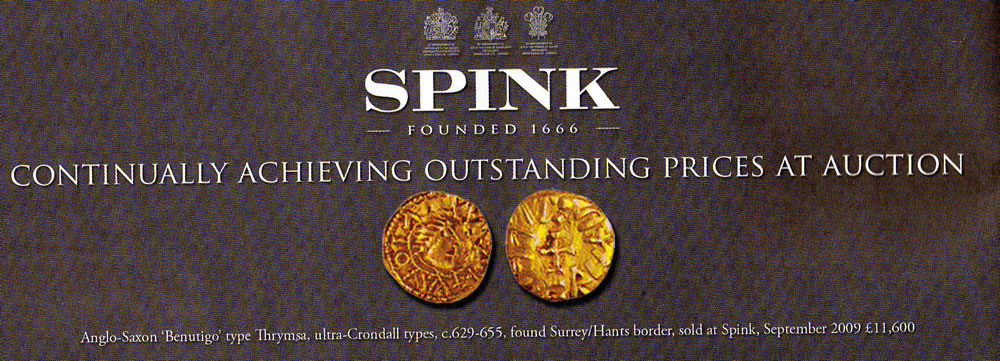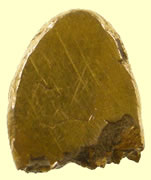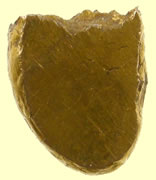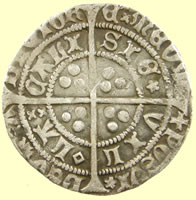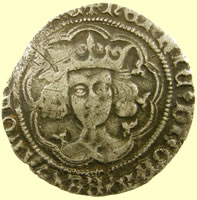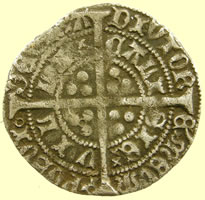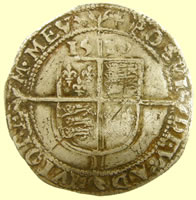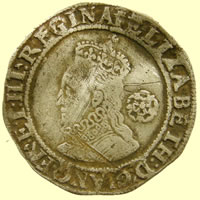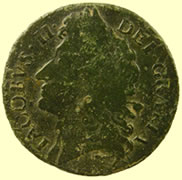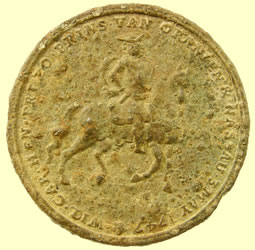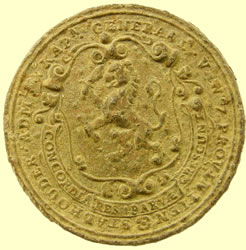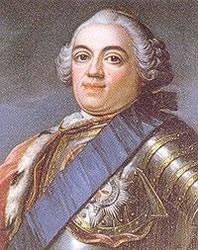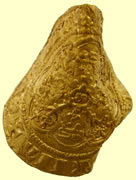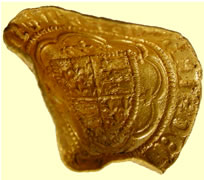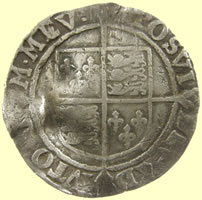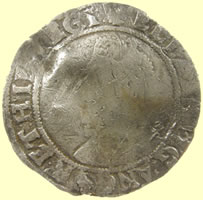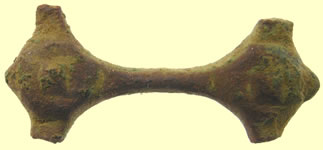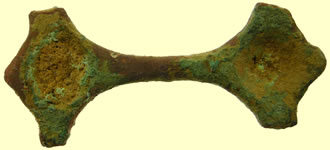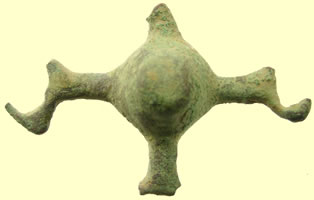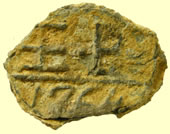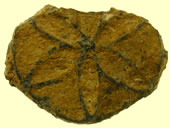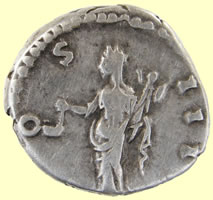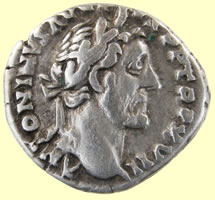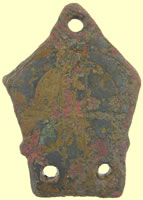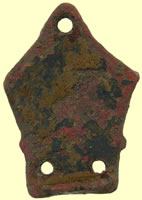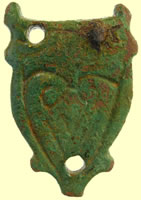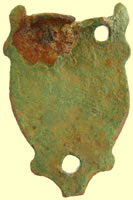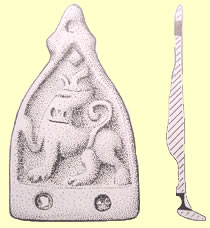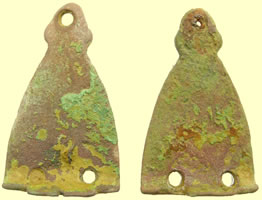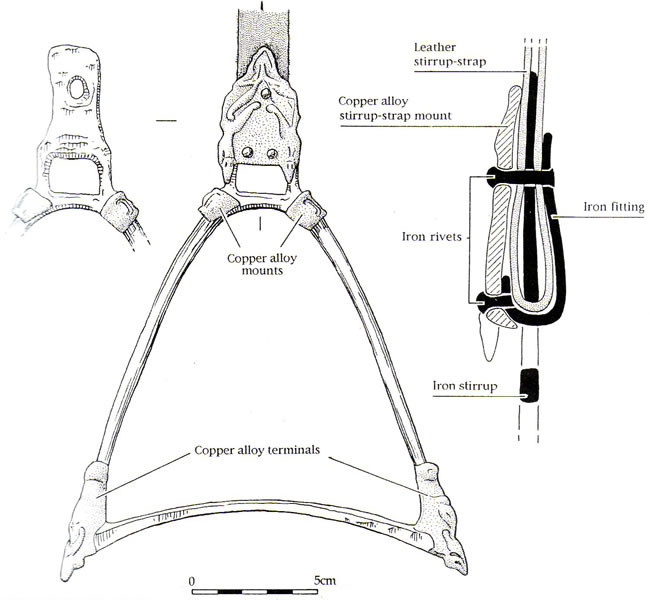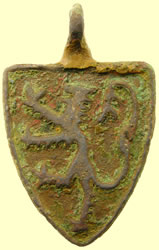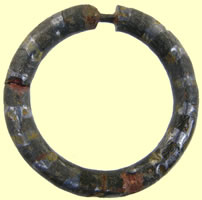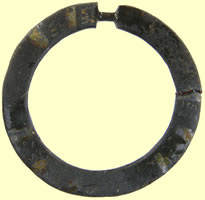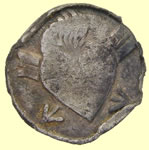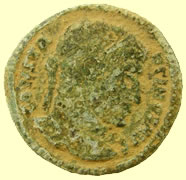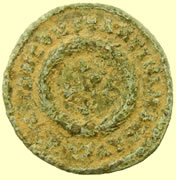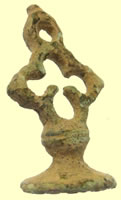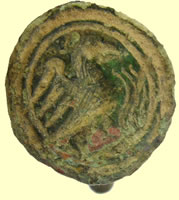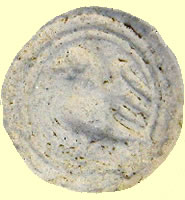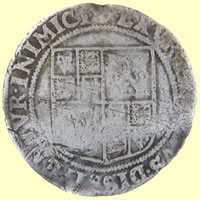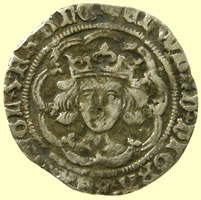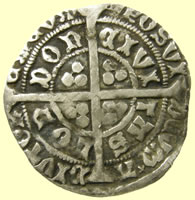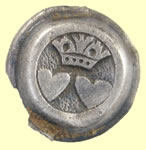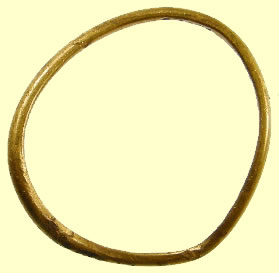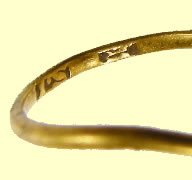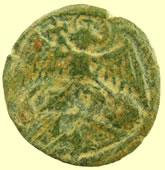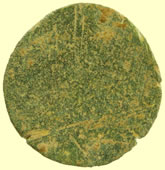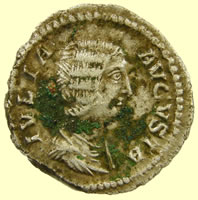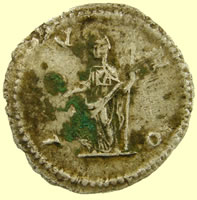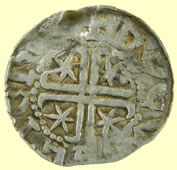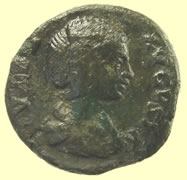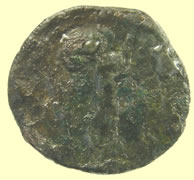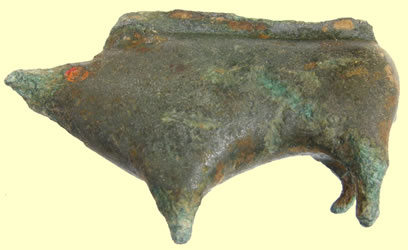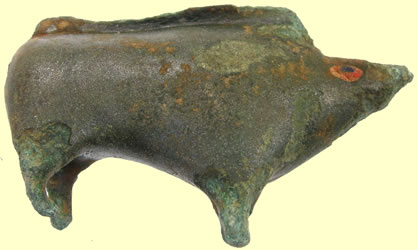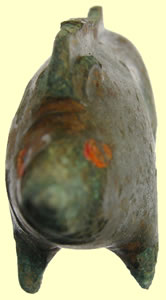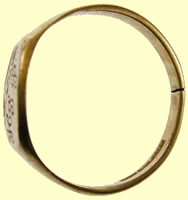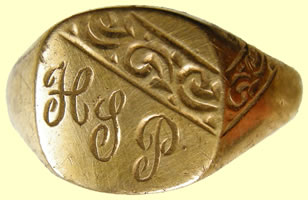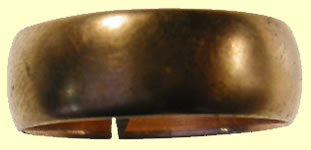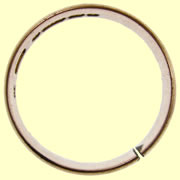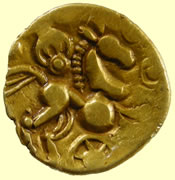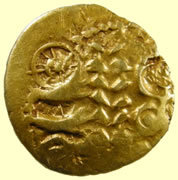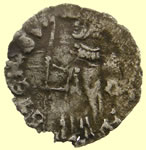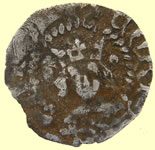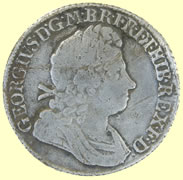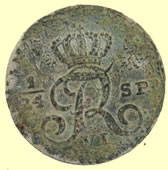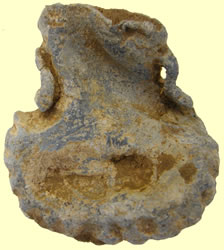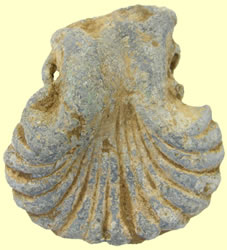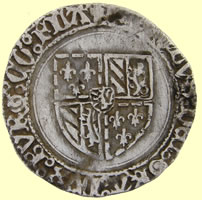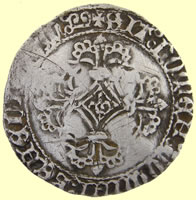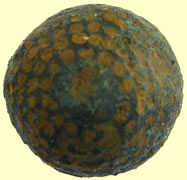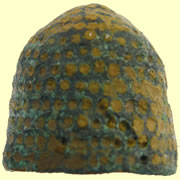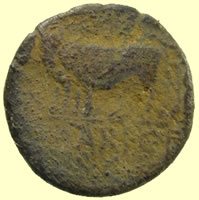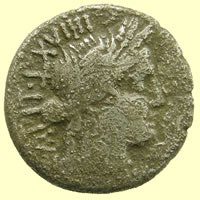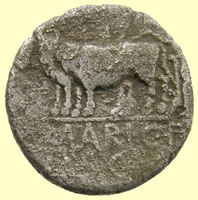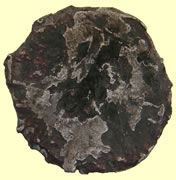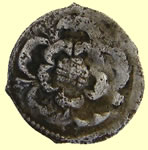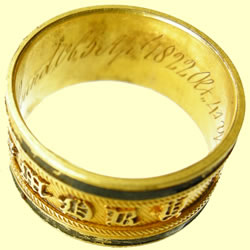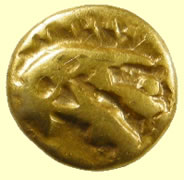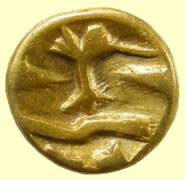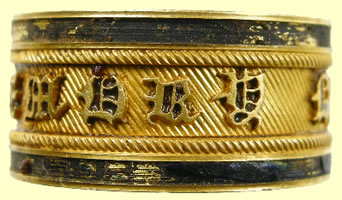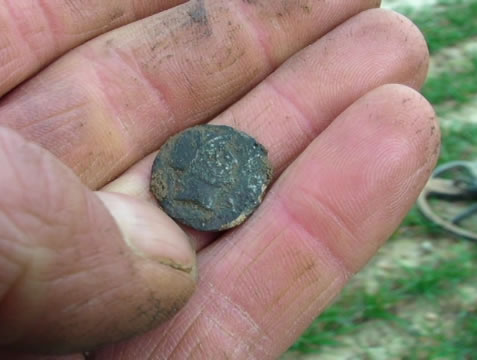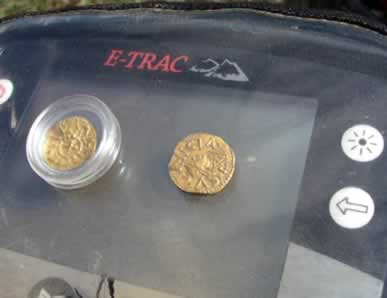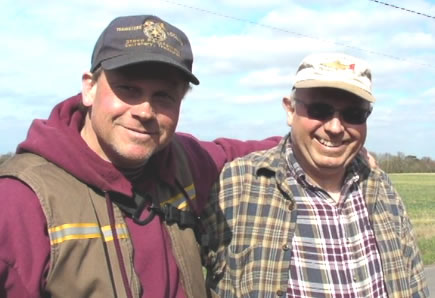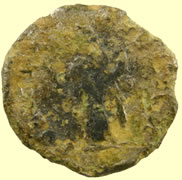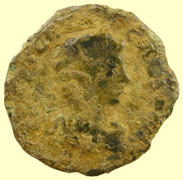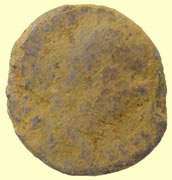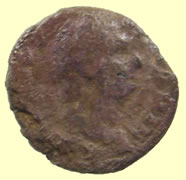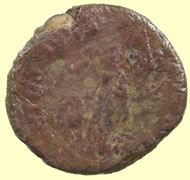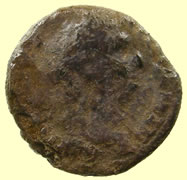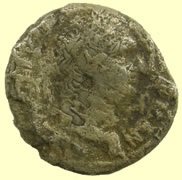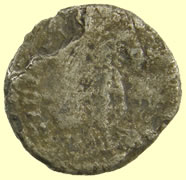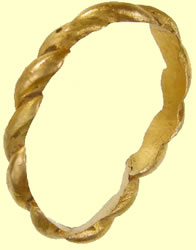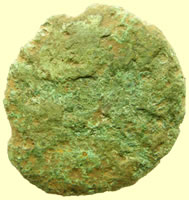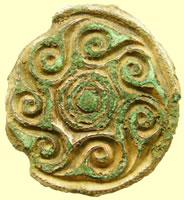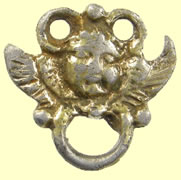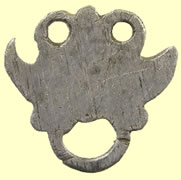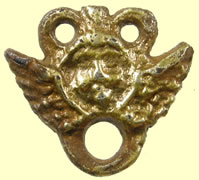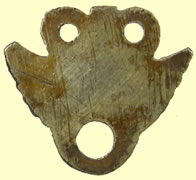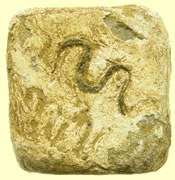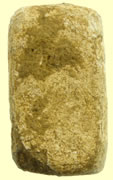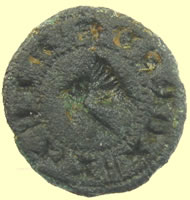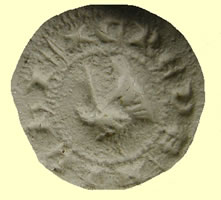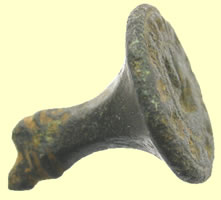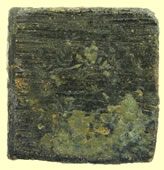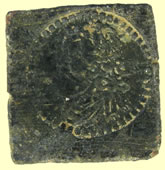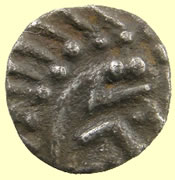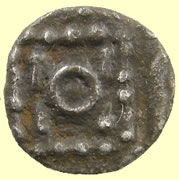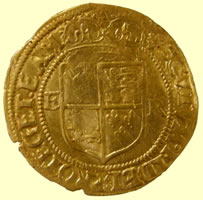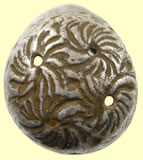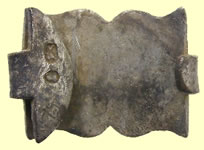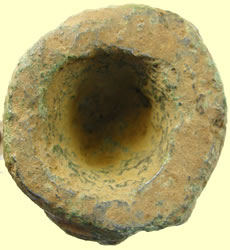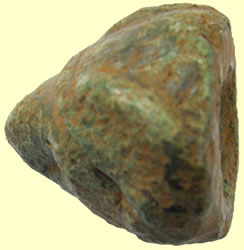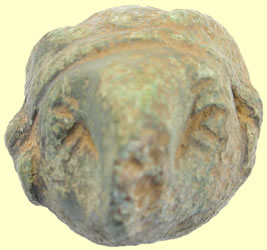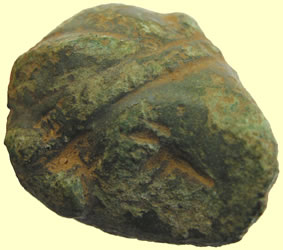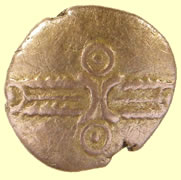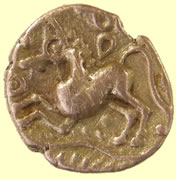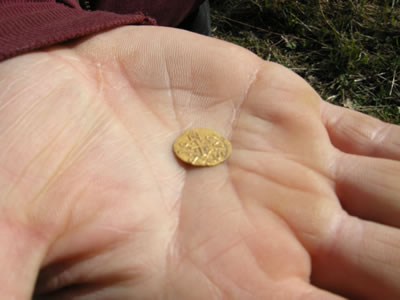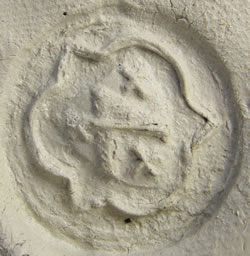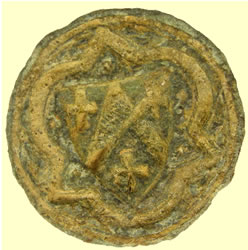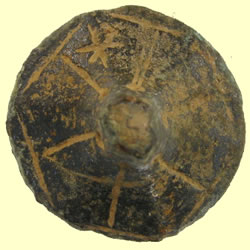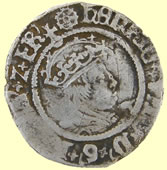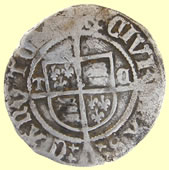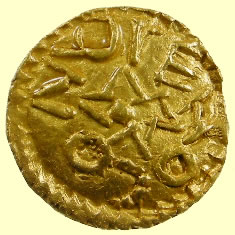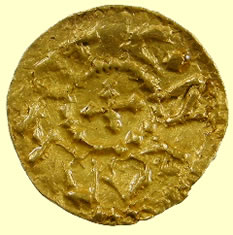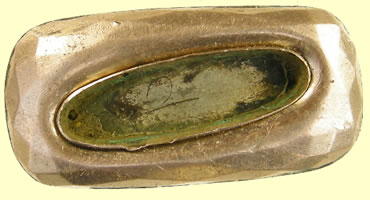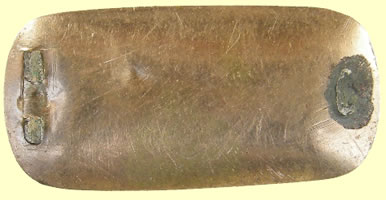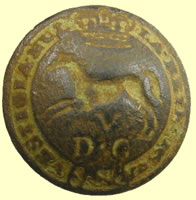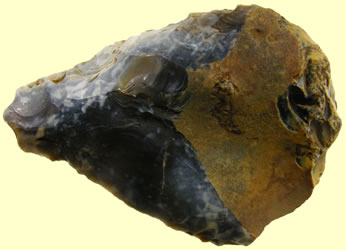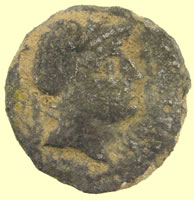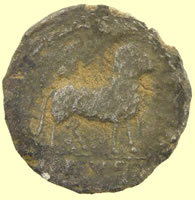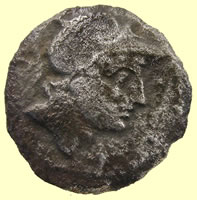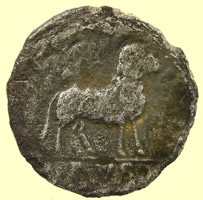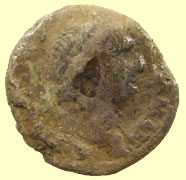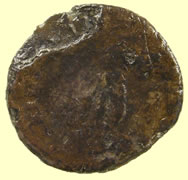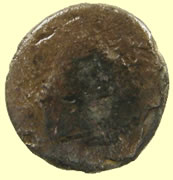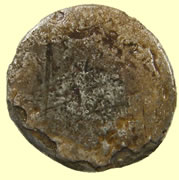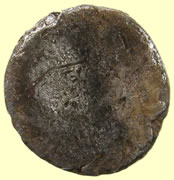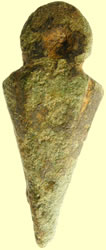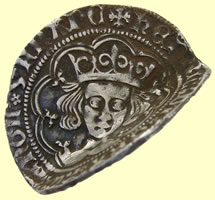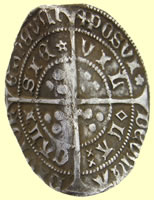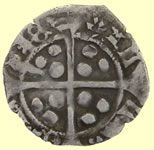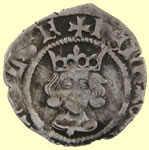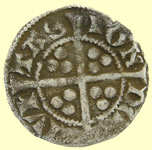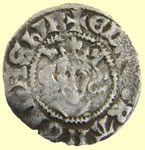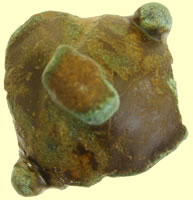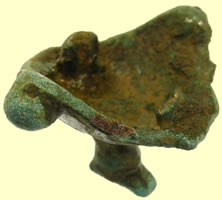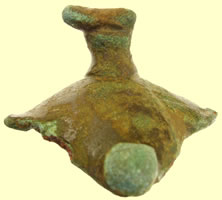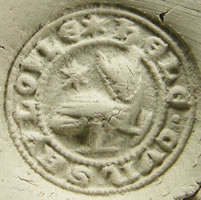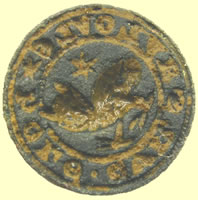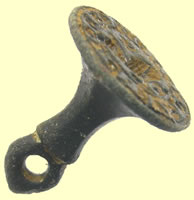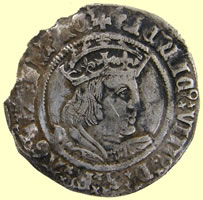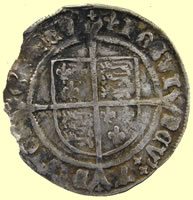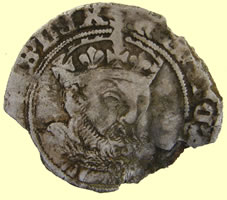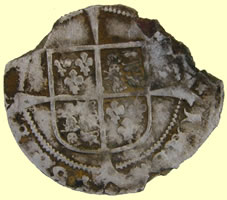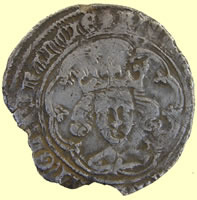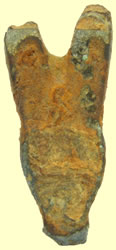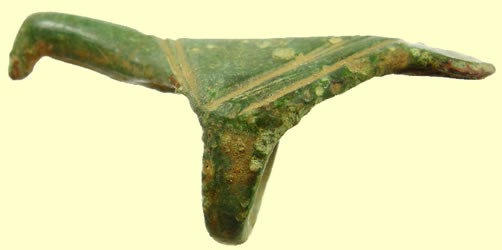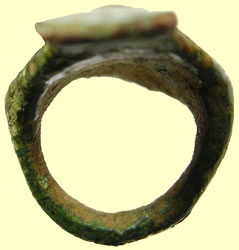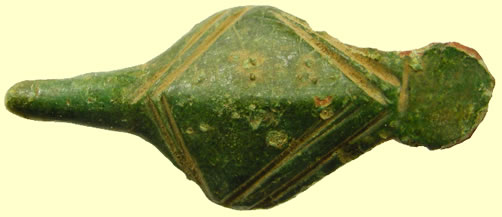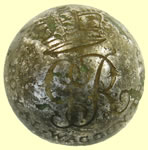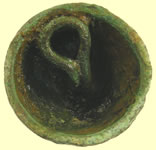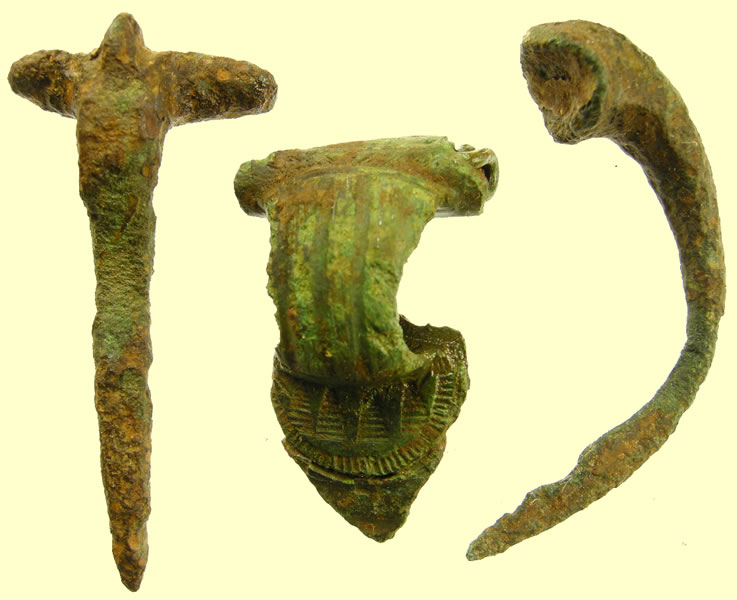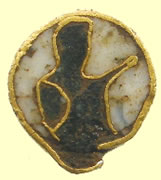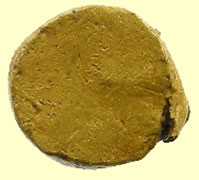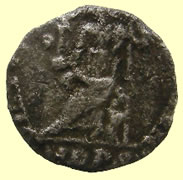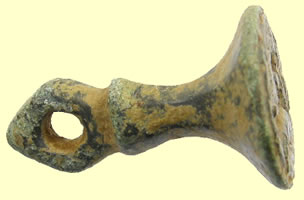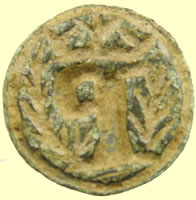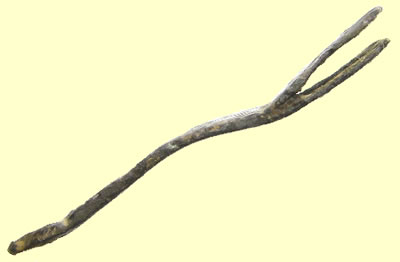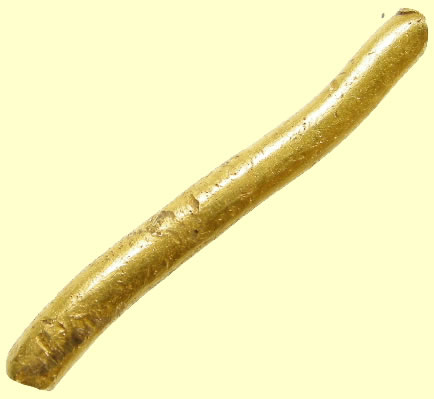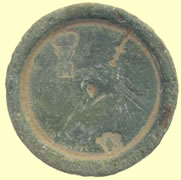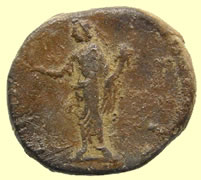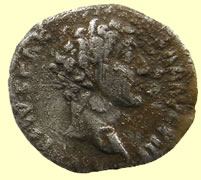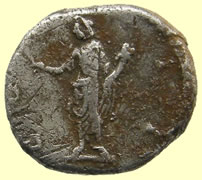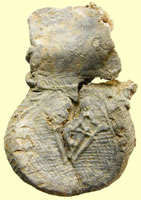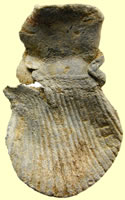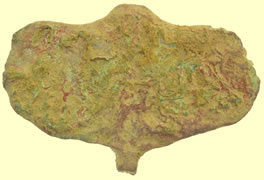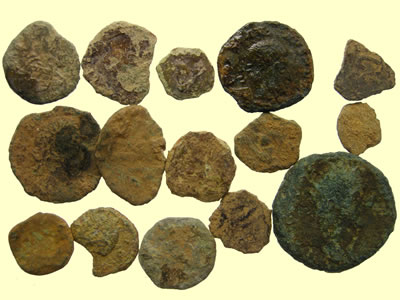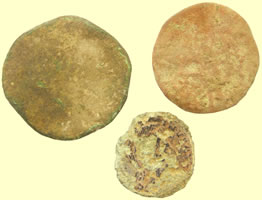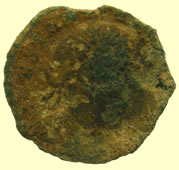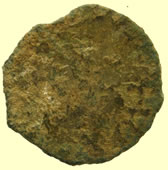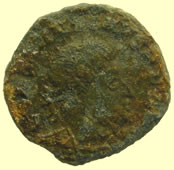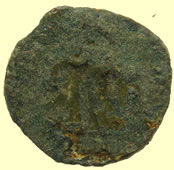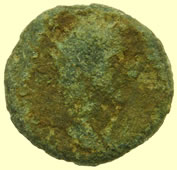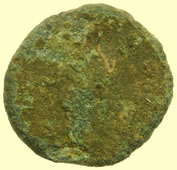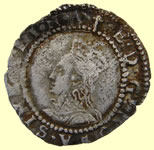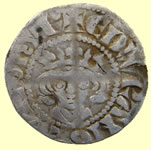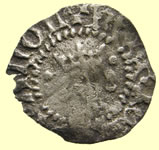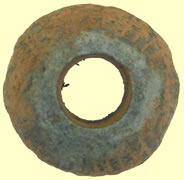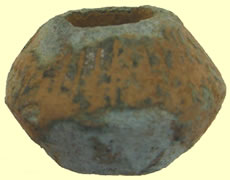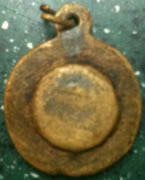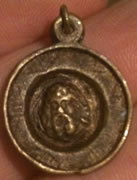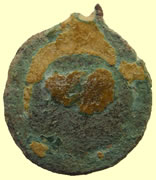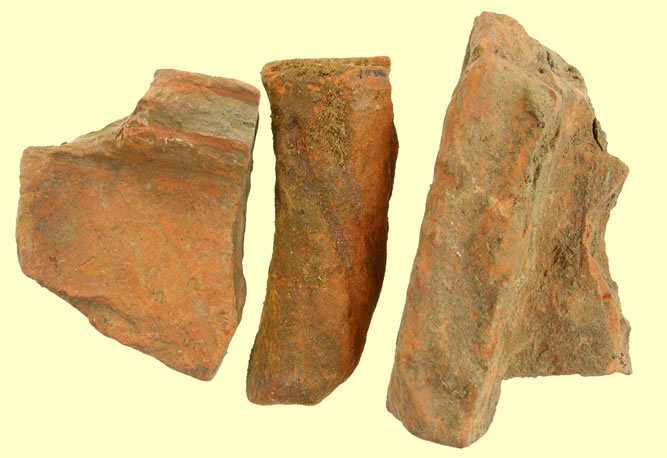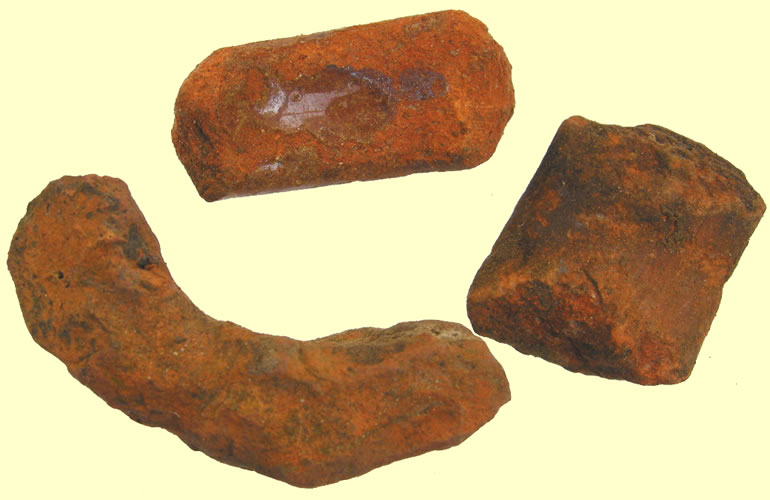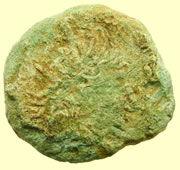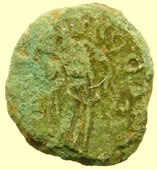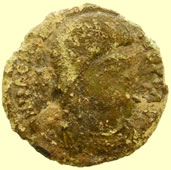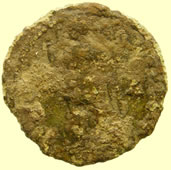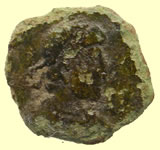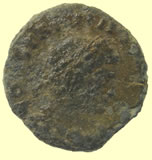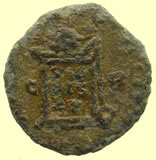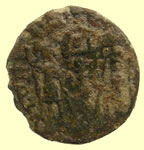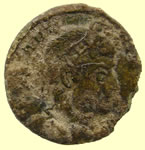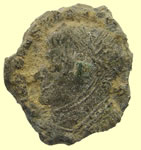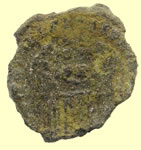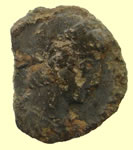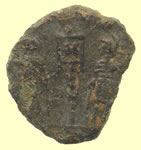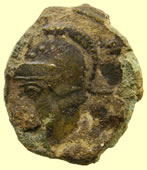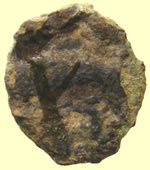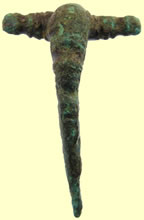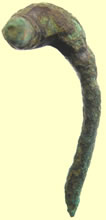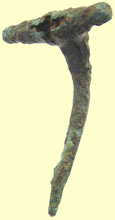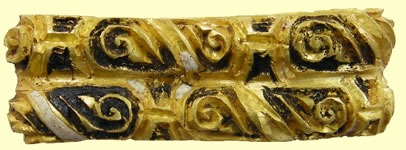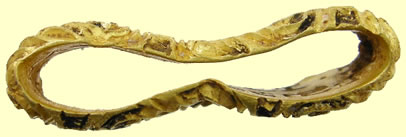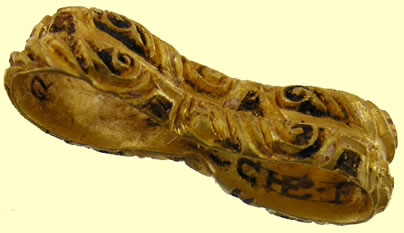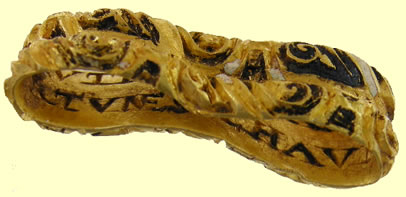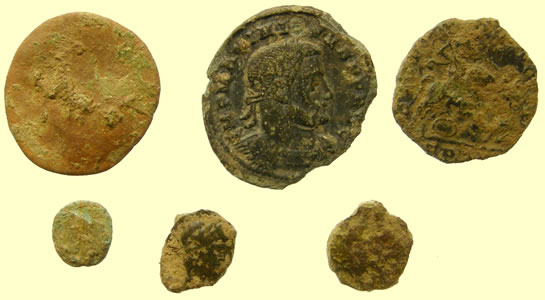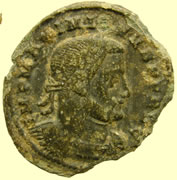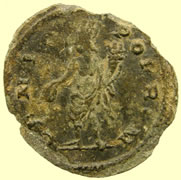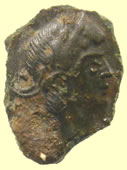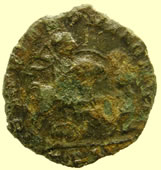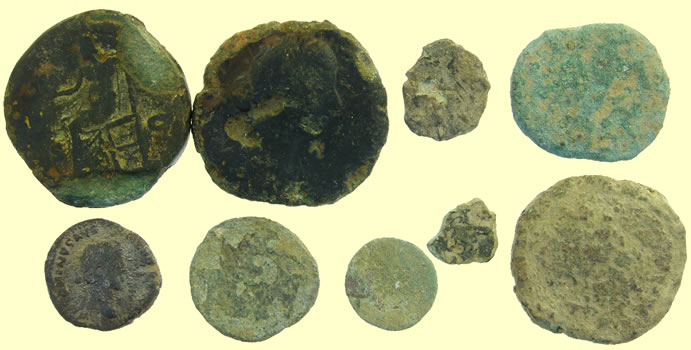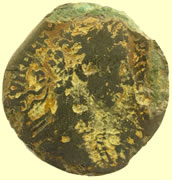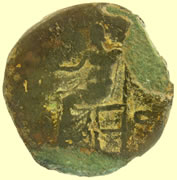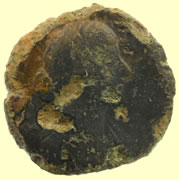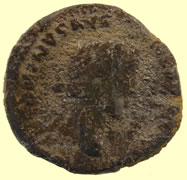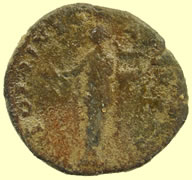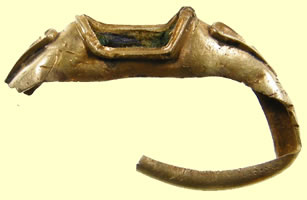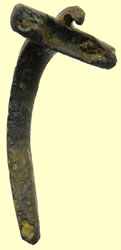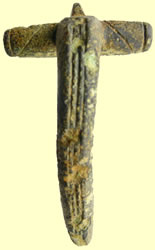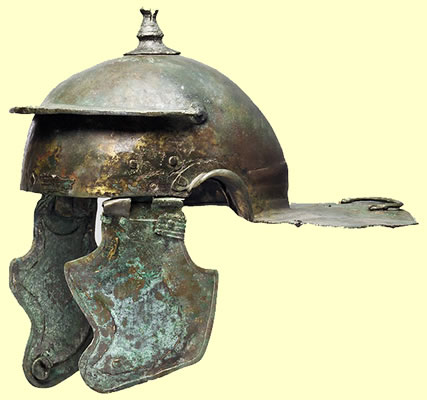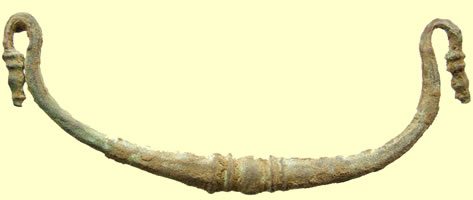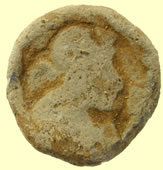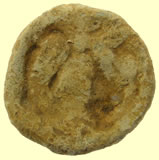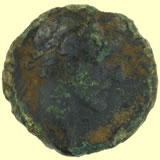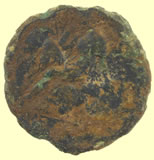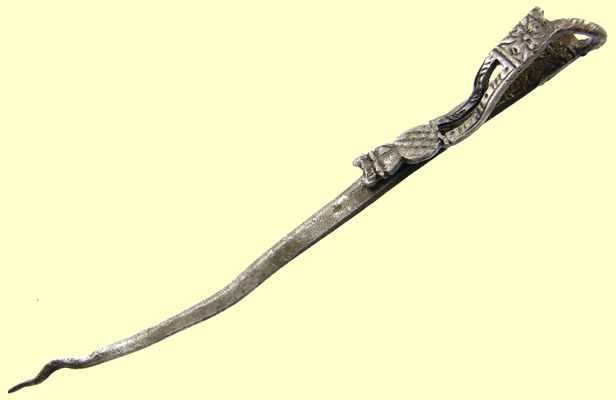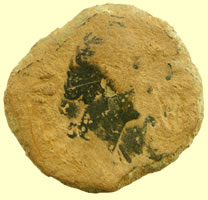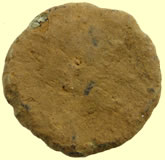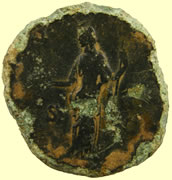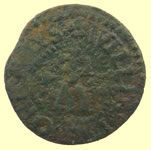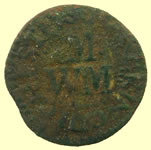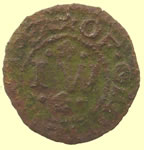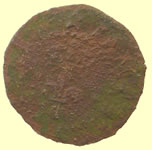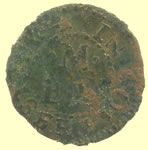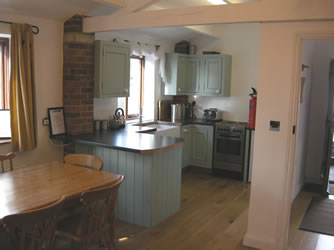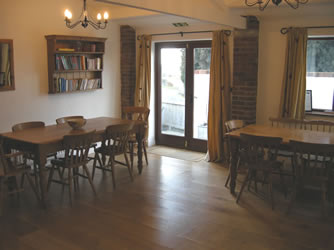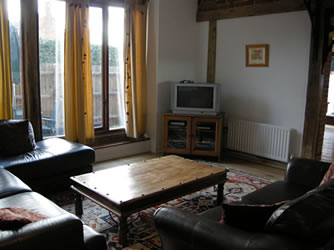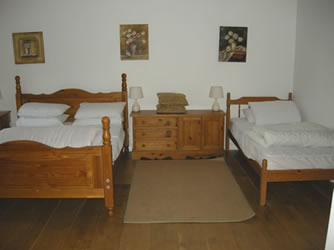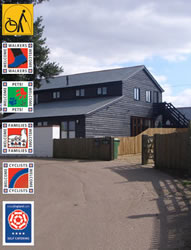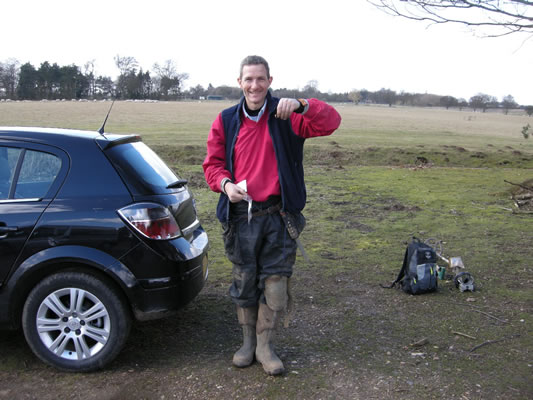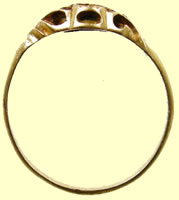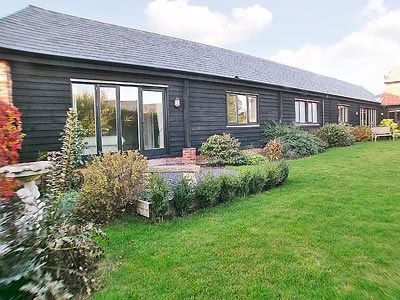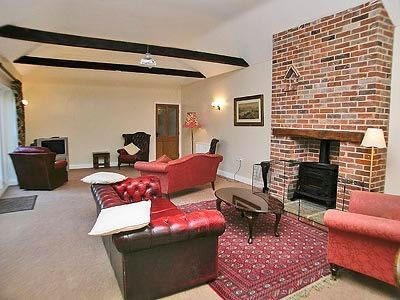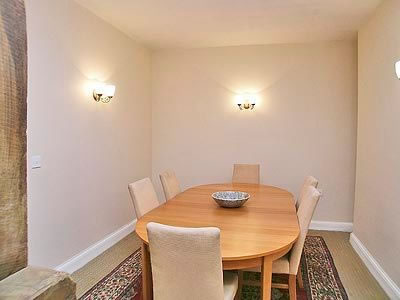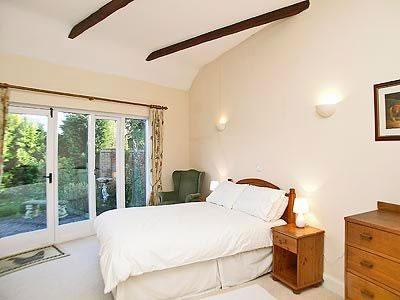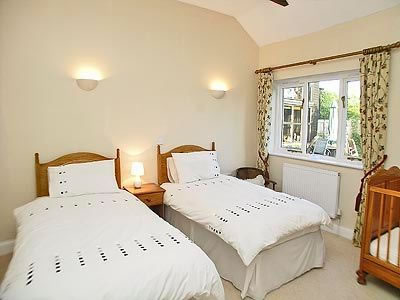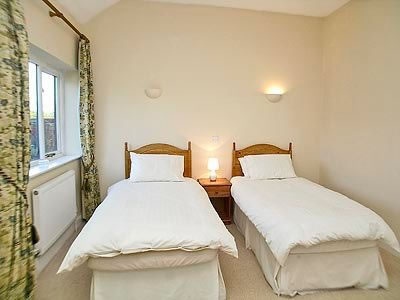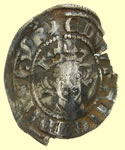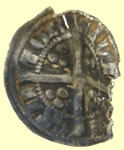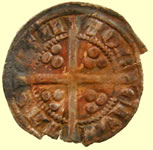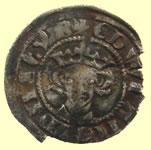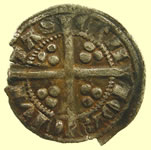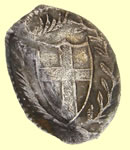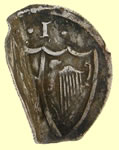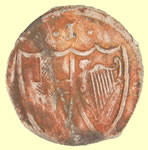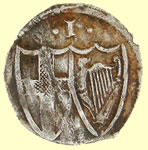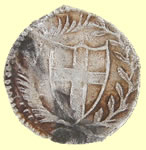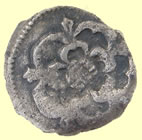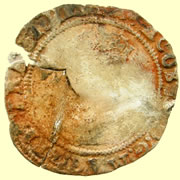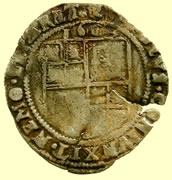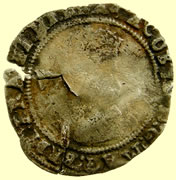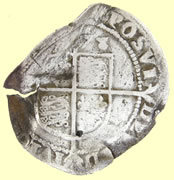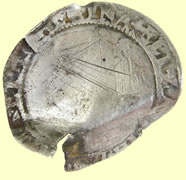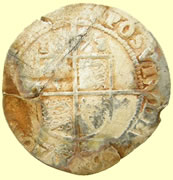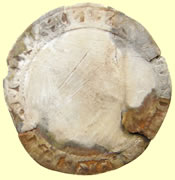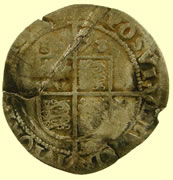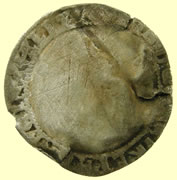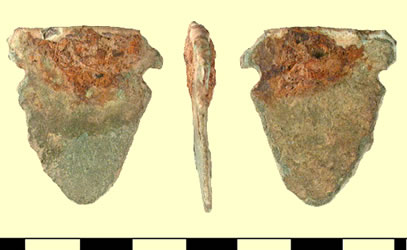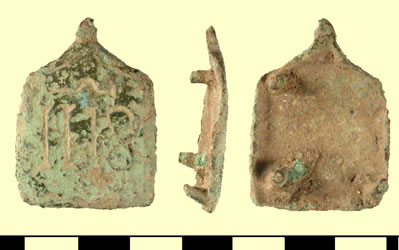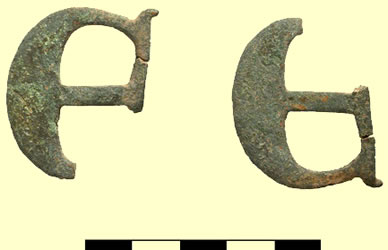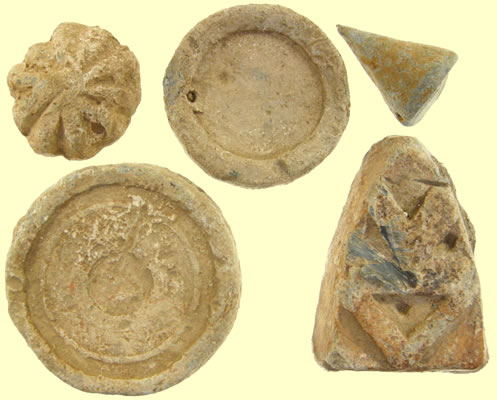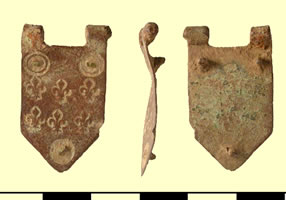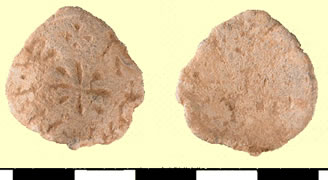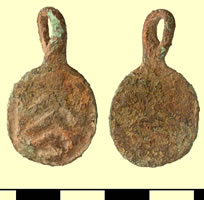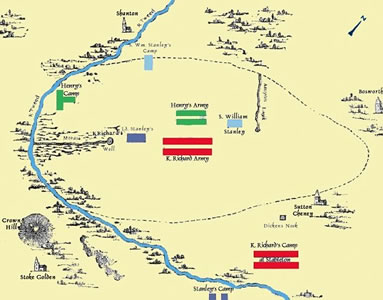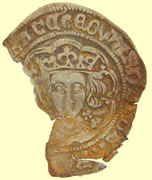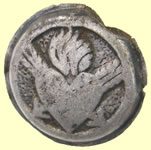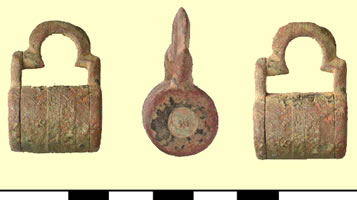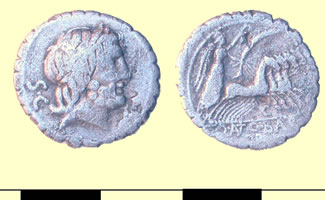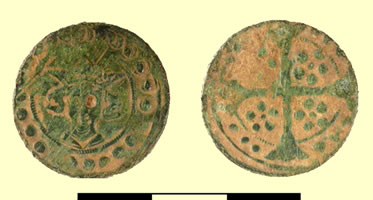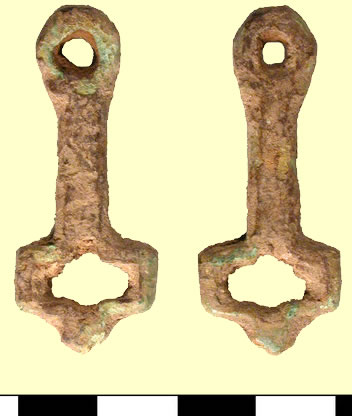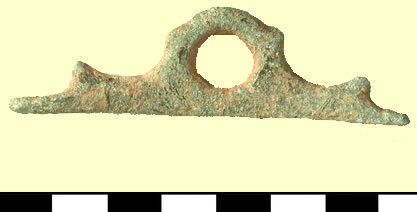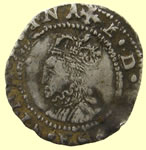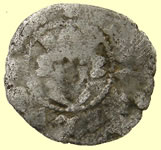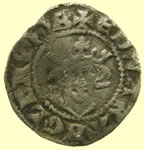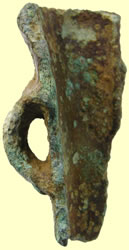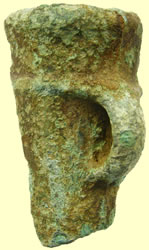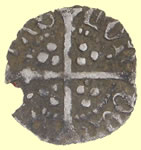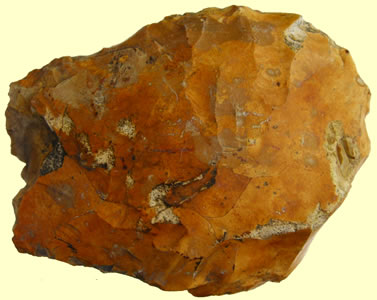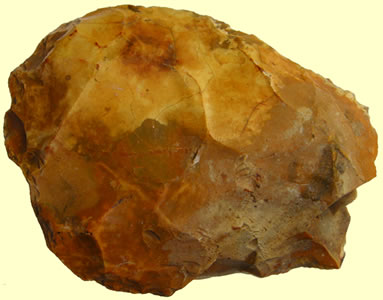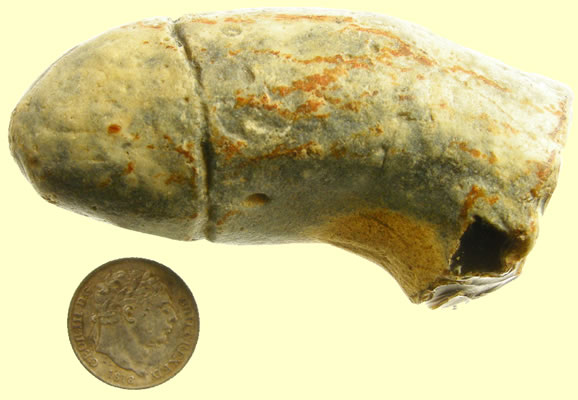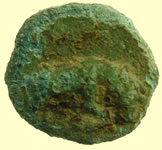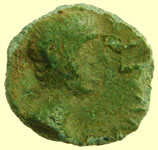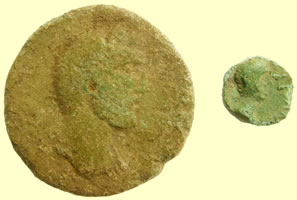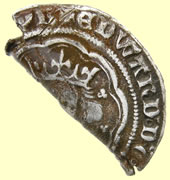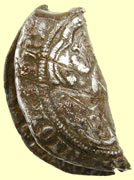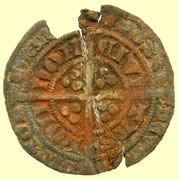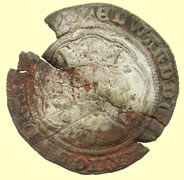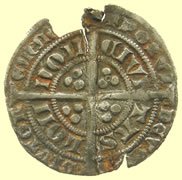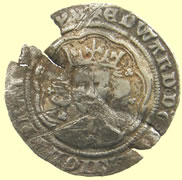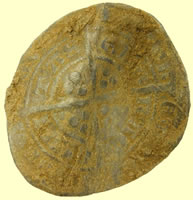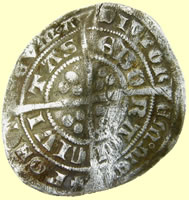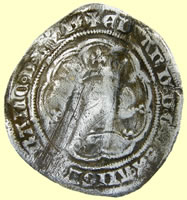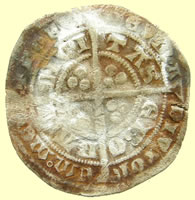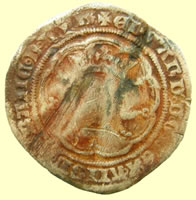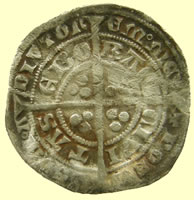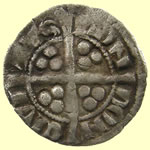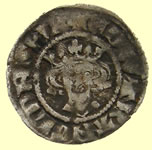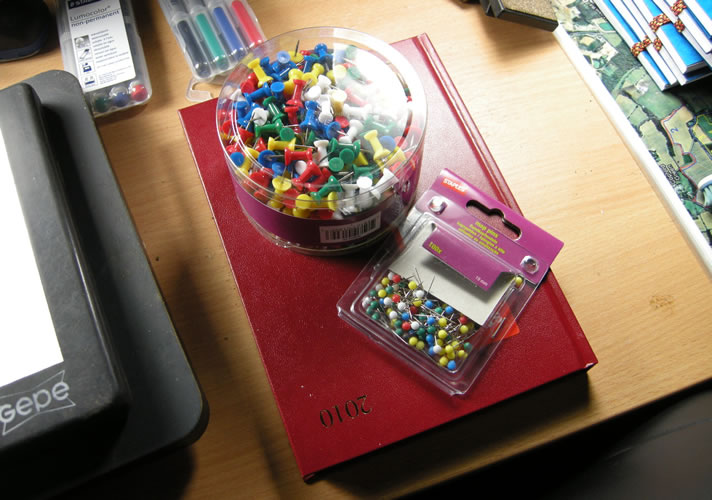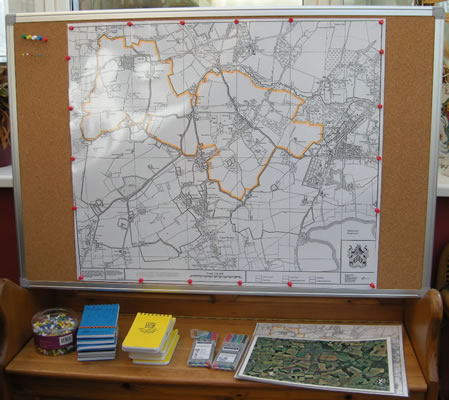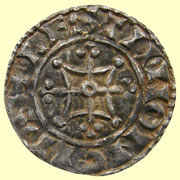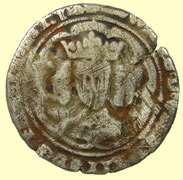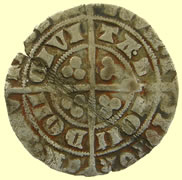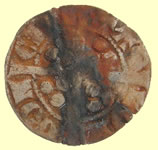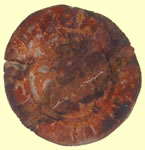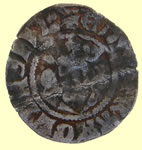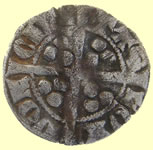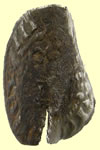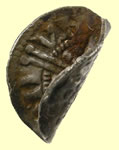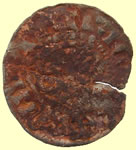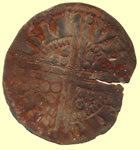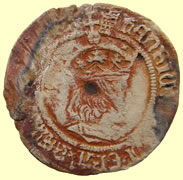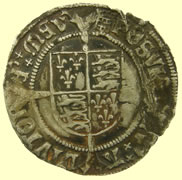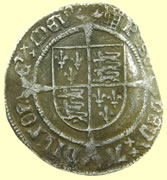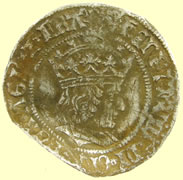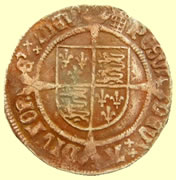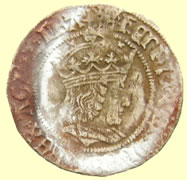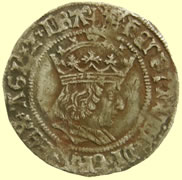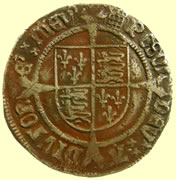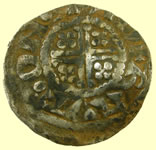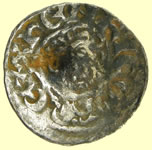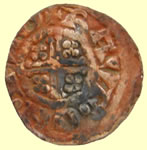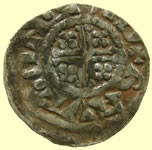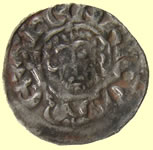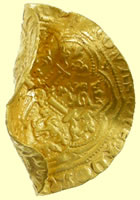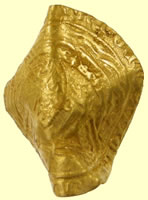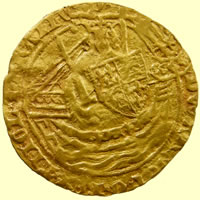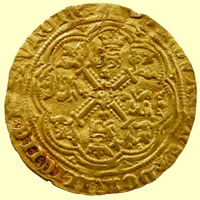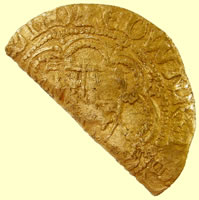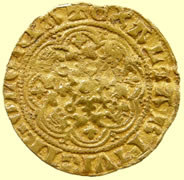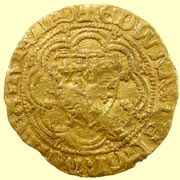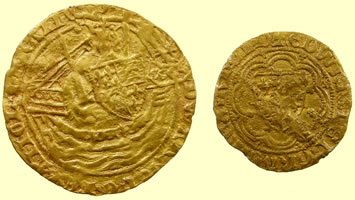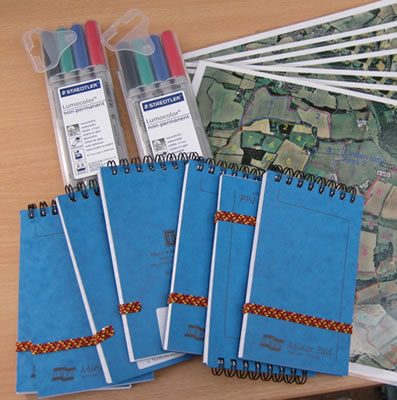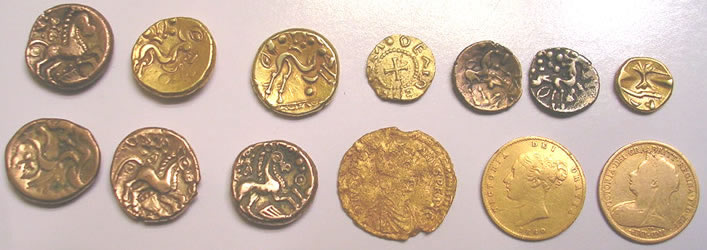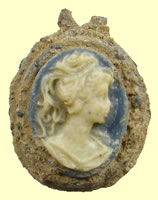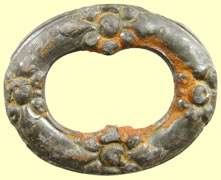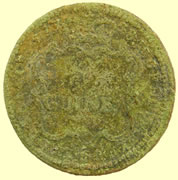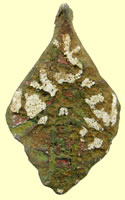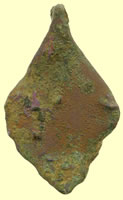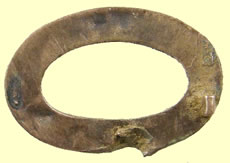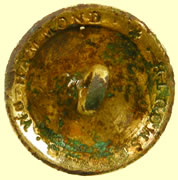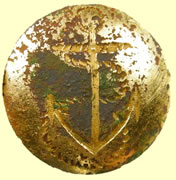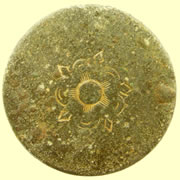

Metal detecting holidays in England with the World's most successful metal detecting club.
Twinned with Midwest Historical Research Society USA
2010 Archived news page Feb 2010 - May 2010 |
||||||||||||||||||||||||||||||||
9th May 2010 Treasure updates - More site updates
Monster find -Circa 1300 BC Bronze age gold open backed triple banded gold ring 3.48g, 13.73mm dia x 6.74mm H Reported to Colchester museum as treasure
I have been receiving lots of treasure updates from the treasure registrar at the British museum issuing treasure case number for our latest reported treasures. I have also receive a number of letters from the coroner's office detailing those going forward for inquest or been disclaimed. The latest is Oregon's Ed's ring above which they have confirmed as a 'Bronze Age composite ring' . Ill Mark's 'silver'' Saxon strapend, he has already donated to Colchester museum, has been disclaimed as not being 10% silver by weight, it has a high copper tin alloy content. Disclaimed items are either that do not fulfil the criteria for treasure or are not items they do not wish to purchase. I updated the hoard and treasure page with the latest updates. Disclaimed items - returning to finder Treasure Case 2009 T523 - Tendring district:16thC pin head - disclaimedTreasure Case 2009 T620 - Post Medieval incomplete silver buckle frame from the Tendring District - disclaimed Treasure Case No: 2010 T167 - 9thC Saxon strapend Colchester area of Essex- disclaimed Treasure Case No: 2009 T614 - Roman bronze coin hoard Colchester area of Essex- disclaimed Treasure Case No: 2009 T521- 16thC silver gilt dress fitting Colchester area of Essex- disclaimed Treasure Case No: 2010 T171 - 17thC silver cufflink Colchester area of Essex- disclaimed Treasure Case No: 2009 T520 - Medieval silver dress fitting Colchester area of Essex- disclaimed Treasure Case No: 2009 T522 - Medieval silver dress pin Colchester area of Essex- disclaimed Treasure Case No: 2010 T37 - Post Medieval silver dress fitting Colchester area of Essex- disclaimed Treasure Case No: 2009 T217- Silver brooch fragment- post 1709 Colchester area of Essex- disclaimed Treasure Case No: 2009 T220 - Post medieval gold finger ring Colchester area of Essex- disclaimed Treasure Case No: 2009 T220 - Medieval silver figure Colchester area of Essex- disclaimed Treasure Case No: 2009 T38 - Post medieval dress fitting Colchester area of Essex- disclaimed ----------------------------------------------------------------------------------------------------------------------------------------------------------- Items going forward to inquest Treasure Case No: 2010 T163. Gold bar from the Colchester area of Essex Treasure Case No: 2010 T169. Gold cloisonné fitting from Colchester area , Essex Treasure Case No:2010 T170. Gold fragment from the Colchester area of Essex Treasure Number: 2010 T165 Post Medieval gold finger ring from the Colchester District, Essex.
More updates to the individual pages below with this seasons finds.
|
||||||||||||||||||||||||||||||||
8th May 2010 More exports and Saxon finds
Very interesting phallus mount - not sure of date - one for the museum Uploaded more export pictures and finds list to the members forum. There were more great bonus do dads in the pouches including 3 more Saxon harness fittings and our first type 10 coiled animal type stirrup mount. Updated the new Saxon harness fittings page I have updated the Forum competition page with the latest copper count
Superb medieval annular buckle
|
||||||||||||||||||||||||||||||||
5th May 2010 More updates - Find of the year voting - valuation appeal upheld
Black Sapphire Medieval gold ring 21.93mmdia,2.51g
Ill Joe who found the beautiful medieval sapphire ring, has successfully appealed the initial offer made to him from the valuation committee. The treasure process allows any finder or landowner to challenge the offer made with other examples of a similar type that achieved a higher previous offer. The valuation committee has agreed to under take a second valuation. Who are the members of the Treasure Valuation Committee?Professor Norman Palmer CBE (Chair)Professor Palmer has been Chairman of the Treasure Valuation Committee since 2001. He is a barrister, a Visiting Professor of Law at King's College London and Professor Emeritus of the Law of Art and Cultural Property at University College London, having formerly been the Professor of Commercial Law at UCL. He is also a member of the Spoliation Advisory Panel. Dr Jack Ogden Formerly Secretary of the National Goldsmiths’ Association, he is an expert on ancient metallurgy and has first-hand experience of the antiquities market. He was reappointed to the Committee in 2001. May Sinclair Appointed to the Committee in 2001, she is the head of the Coin Department at Spink & Son Limited, one of London’s leading coin dealers. She is a respected expert on Medieval coins. John Cherry Former keeper:Romano British Antiquities at the British Museum Peter Clayton Writer, Lecturer and expert on ancient archaeological artefacts Professor Ian Carradice Visiting Professor, American Numismatic Society, New York Dr Tim Pestrell Curator of Archaeology at Norfolk Museums and Archaeology Service Dear Mr Labedzki, Treasure Act 1996: 2008 T580 Medieval gold finger-ring from Tendring District, Essex At its 14/04/10 meeting, the Treasure Valuation Committee inspected the find and took the Finders submission into consideration, noting the disparity in mass between the Dunterton example (2005 T206,Treasure Annual Report 2005-6, item 402) (5.6g), and the piece being valued (2.48g). It pointed out again that the heavier weight of the Dunterton ring made it much rarer, and thus more desirable. On reflection, however, the Committee felt that it may be the case that the relative value of this ring in respect to the example from Bexhill, East Sussex (2005 T214, Treasure Annual Report 2005-6, item. 407, valued at £2000) deserved further thought. The Committee agreed that itwould benefit from further guidance from an independent valuer, and it decided to seek a second valuation. Yours sincerely, Janina Parol Assistant Treasure Registrar British Museum
Just 5 days left before voting closes on the 10th May for you 'find of the year' choice, winner will be announced on the 11th May. I just posted Boston Dan's export pouch on the members forum and he had a couple of bonus Saxon harness bridal bit fragments like Beau's one below which I will take photo's of later. Bjorn the Saxon/Viking expert has confirmed it is a Saxon harness fitting not Viking I'd say it's a fragment of a cheek-piece from a bridle bit. /N B
Saxon harness fitting 45.7mm L x 37.82mm W
Updated a load more individual find pages with the latest finds below. I have also sorted the Edward III page into denominations and will have to split this page shortly as it has grown too large. I have updated the Forum competition page with the latest copper coin count.
|
||||||||||||||||||||||||||||||||
1st May 2010 More exports - More updates - Find of the year voting I have uploaded a load more export pouches to the members forum including several that had the disclaimed Roman bronze/silver hoard coin. Remember only those officially disclaimed treasures and hoards will appear on your export applications. Those that are still with the British museum under evaluation and could be purchased by the museums will have a 2nd export application made if they are eventually disclaimed. The finds of the year voting has had a massive turn out from the members. 12 items are being voted for. The top find so far has 32% of the vote so it is no landslide this season. Only 7 votes separate the top two finds so it could still change with voting ending on the 10th May. I have updated the Forum competition page with the latest copper coin count. I have updated loads of individual find pages below with our latest finds.
|
||||||||||||||||||||||||||||||||
25th April 2010 More exports and updates Boston Beau had a really nice bonus do dad in his export pouch which appears to be a Anglo Saxon harness fitting and the first of that type we have found. I have sent it off to Bjorn the Viking/Saxon expert for his views. I have posted more complete pouches with photo's and find lists on the members forum. I have updated the Forum competition page with the latest copper count
50BC Celtic silver 'face horse' type 1.06g - 14.18mm Just got back the CCI record number from Ian on the Celtic silver find I sent him last week. He has confirmd my original ID. I have given this coin the CCI number 10.0903.
The ID is fine - it is one of the so called 'Normal Face Horse' types, probably NFH A. East Anglian (Icenian) type of c. AD 20-50. These are the latest of the uninscribed silver struck in that area and probably overlap with the inscribed coinages. However, they are nothing to do with Boudicca (as Van Arsdell suggested!)
Thanks for the info!
Ian
Saxon harness fitting 45.7mm L x 37.82mm W More updates to the hammered silver pages with out latest finds below.
|
||||||||||||||||||||||||||||||||
22nd April 2010 Huge updates and new pages Uploaded more export pouches and finds lists to the members forum
Pensioner uncovers £500,000 treasure I have updated a load of the Roman and Saxon pages with the latest finds. I have created a new Saxon harness fitting page and will need to create more sub division pages to make the pages smaller. I have separated out the Roman jewelry page to make viewing finds easier. I have updated the Forum competition page. Ill Mark's pouch added 120 coppers and Mindy's another 100 to the total.
|
||||||||||||||||||||||||||||||||
20th April 2010 Started the export pouches - Bonus do dads
NH Dave had an amazing hunt with that very rare 'Heybridge Horse' Celtic gold coin find and with all the excitement did not get around to showing me a lot of his best finds. This is why the export process is such an important exercise where every metal find during a guys hunt is re- examined closely again. I cleaned up a crusty square lump to reveal the first Ferdinand & Isabella coin with with 2 opposing busts we have found, what a neat find. I also cleaned up the boars head knife pommel to reveal is was once silvered and has two glass stone eyes. I don't get a 'feel' for the date of this relic so one for the museum to evaluate. Dave also had two neat Saxon pieces and the middle part of a medieval purse bar. I was amazed to discover another one of those medieval Knight's templar badges in great shape. I cleaned up some really early military buttons including a stunning 18thC 81st regiment of foot officers version. Dave added another 56 coppers coin finds to the forum competition so the total now stands at 2229. You can check your guess and the current totals as I process each guys finds pouch here Forum competition. It was a real bumper 2nd half of the season so I expect this total to be around 3500 to 4000 coins in the end. Remember to keep sending in your 'Find of the year' votes, closing date for voting is 10th May. Current voters list is posted on the members forum and it is very important for every member to have their say. Only those members that vote will be eligible for next years win a free weeks trip competition.
Medieval badges Ref Mitchiner p244 939 - 941
19thC livery buttons
|
||||||||||||||||||||||||||||||||
18th April 2010 More cleaning and 'cooking' - Saxon pieces Treasure hunt group are in for £40,000 after discovering the first penny I have managed to get good detail from the obverse of the 'cooking' Celtic silver coin so I have now weighted it and sent it off to the CCI for recording, what a great find under the crud !! I have put it back in the 'cooker' to remove what looks like copper covering the horses head.
As dug to partially cooked Celtic silver coin - East Anglian face horse type 1.06g - 14.18mm
I got a great e-mail in from Paul Withers who writes all the coin & trade weight books and also the medieval English hammered silver coin book series I use as my 'Bible'. He has sent me some great amendments to the coin weight page which I have updated. Paul is going to lend his expertise to our site and I can also send him our 'unrecorded' silver hammered coins for inclusions into his books. As Paul sends us more amendments I will further update the pages.
Bjorn the Viking/Saxon expert has sent me more great links on padlocks and there is an exact match to Bonnie's very rare horse padlock - no5166. I was discussing our bridal cheek pieces and stirrup mount finds with Bjorg so he has sent me a great picture of bridle set up with single knopped ended harness guides.
Bjorn has also agreed to be our club expert on anything Viking/Saxon. When we make any find of that period now I will send Bjorn pictures for his comments. Some links: My paper (or at least one of them) on Norse padlocks: Horse-shaped padlock no 1: Horse-shaped padlock no 2: Anglo-Danish/Norse bridle mounts: "Our" padlock is still undergoing conservation but I'll see to that you get photos of it when it's finished. Regards Bjorn
I have been doing more work on the finds 'cooking' and soaking.
This medieval quadrefoil pendant has been soaking for 3 weeks and finally I got the detail to come through - stunning red and green enamelled lion with fleur de lis
Finally 'cooked' Roman silver, great detail under the crud -Denarius of Severus Alexander |
||||||||||||||||||||||||||||||||
16th April 2010 Ron's vid v2 uploaded - Stunning medallion - Mega rare padlock The new PAS finds.org database is now up and running with an excellent user friendly interface. They are still working through some minor glitches but it can be viewed at: http://www.finds.org.uk/database/ I now have the ability with my ID to directly upload our finds with photo's onto the database giving full details of the find, weights, dimensions, find spots etc . I can add extra notes like Mark Lehman's Roman ID's etc and then fire them off to the database. They will then be checked for accuracy and approved or more information can be requested. This a massive saving of time for the local FLO who previously has to physically re-photograph each of our finds and fill in this information again after I took in a huge bag of relics for recording.
Chicago Ron sent me another bunch of great video clips from last weeks hunt that I have added to the existing compellation. It includes same more classics like Mindy finding the landowners families gold mourning ring which she later presented to him. She even does the gold dance !! Either download it or stream it. http://www.colchestertreasurehunting...ron2010HD2.wmv
1351- 1361 Edward III hammered silver groat (4 pence ) - Cross 3 Pre treaty period Obv EDWARD D G REX ANGL Z oFRANC oD oHYB Rev - CIVI/TAS/LON/DON - London mint 27.66mm, 4.50g I have just finished cleaning up the last batch of fixed hammered silver coins and what could be a very important find by Min Daryl. He left me a large copper disc that was folded in the middle and asked our goldsmith to straighten it if he could. Another brilliant fixing job as it is now as straight as a die and you can clearly see what looks like Christ holding a sword. Is it a mount or a medallion ? One for the museum to evaluate.
Large medieval copper medallion - Christ holding a sword ? 43.78mm dia
I just got a great e-mail in from Bjorn at the Stockhome Archaeological Research laboratory ID'ing what I thought was a Roman votive offering. It is in fact a very rare padlock with explains it's hollow construction and the 3 cut outs in it's rear. I spoke to Bjon on the phone this morning and this find is only the 2nd one with provenance, the first one found was from a town with a history no later than 925 AD. It is possible however that this padlock could have been in use for several hundred years so late Roman or Viking is currently the best guess. It will be interesting to see what the British museum experts make of this find. Bjorn has written a paper on padlocks and is going to send me the report. He is also writing a paper on Saxon/Viking harness fittings which he is going to send me a copy of. Hi My name is Ny Björn Gustafsson and I'm a Swedish archaeologist working for Stockholm University. By chance I went through Your display of finds and there I to my amazement found an almost twin of an artefact currently undergoing conservation in our lab. It is the so-called "Roman bronze votive animal" found by a certain "Idaho Bonnie". For your information it is not a votive piece but a horse-shaped padlock. I would greatly appreciate if it would be possible to contact the finder/for the finder to contact me on this e-mail address! To date I know of only 4 locks of this type, of which 2 is in private collection and lack all provinience. You've made a stunning find indeed! Kind regards /Ny Björn Gustafsson
Very interesting hollow Roman/Saxon padlock - red enamelled on head on nose 3 cut outs to rear 38mm L x 27.8mm H - 10.06g
|
||||||||||||||||||||||||||||||||
13th April 2010 Huge finds video uploaded - Accommodation over view page Archived half of this news page to speed up load times Oct 2009 to Feb 2010 There is now an accommodation over view page on the holiday site. There are 4 'Barn' self catering houses you can use now, you pick the one that suits you best. The full board is totally booked for fall 2010 from opening to the end of Oct. You can join any 'Barn hunt' with free slots during that period or use local hotels. Ill Tim will be running a 2nd Barn hunt at Barn III if there is sufficient interest. This is a go as you please hunt with your own mini bus and you can detect as many hours as your arm holds out. All the groups have the same access to the 300 + fields available for detecting. His dates are: 8th to 15th Oct and 15th to 22nd Oct Drop me a mail if you want to join Tim's Barn hunt. enquiries@essexfarmholidays.co.uk Louisiana Sal is now doing a 2nd 'hard core' Barn hunt each year and has reserved the 26th to 5th March 2011 at Barn II to search our new land for the 2nd half of the season. He has limited spaces and this is serious 12 + hour days. Drop Sal a mail if you are interested. Chicago Ron left me hundreds of clips of the guys digging finds in the field and I have compiled some of them into a huge 35 minute video. There are some absolute classics like when the two Mark's found their gold coins and the Saxon boys finding the gold hoard. Ron takes the vid's in full HD so I have made this video with better than normal streaming quality so it is 170 Meg. Ron has a bunch more clips he is going to send me yet but this video gives you a good taster. Click here to watch or download vid
Click here to watch or download vid
|
||||||||||||||||||||||||||||||||
12th April - More monster Celtic finds - cooked Roman silvers - Ron wins dedicated detectorist yearly award
Chicago Ron at the club raffle draw Chicago Ronnie stands out for the clubs most 'dedicated detectorist' this season especially after his last 3 week stint. His arm was totally shagged, his back had gone, he could not even moved his neck from side to side and he was still out there swinging. The only way Ronnie would stop detecting is if he died and even then his hand would still be twitching out of the coffin. Even after 3 hard weeks of hunting he was going to be in London looking at the sites and museums for 3 days. He was back up here by 6pm wanting to hunt again after a quick 10 minutes around the British museum. That is one dedicated or serious addicted guy. Great win for one of the clubs hardest and most successful members The last guys left this morning and even on their last half day managed to pull up one of our best ever Celtic relics and part of a 850 BC socketed bronze age axe. Idaho Ray on his first trip here pulled up a full medieval silver groat and then this stonking Celtic dragon headed toggle fastener, stunning find. Then this morning while I was playing with the 'cooking' Roman silver coin finds what had appeared initially to be a crispy 5thC Roman silver coin gave me a massive shock. Where the crust had melted off one side I instantly recognised the bust as a Celtic silver coin. The first Celtic silver coin off our new site and the first of that type we have ever found. Hopefully the obverse has good detail as it should have a horse on it. At the moment I have 5 other crusty Roman silver's 'cooking' and the detail is starting to show through of several of them. I have still got a bunch of finds to upload to the latest March II finds page today
As dug to partially cooked Celtic silver coin - East Anglian face horse type
As dug and partially 'cooked'
Almost 'cooked' , below is Mark Lehman's initial ID, I have resent it to him now I have 'cooked' it better You seem to be getting a lot of unintended small change lately - This is a denarius of Severus Alexander - the last member of the Severan Dynasty, 222-235 AD. This one should read: IMP C M AVR SEV ALEXAND AVG on the obverse and ANNONA AVG on the reverse. In addition to the missing parts, there seems to be either a squashed letter "A" or a letter "I" in error at the end of ANNONA. Annona was the allegorical personification of the grain supply - yes, it was THAT important to the Romans so that it required a minor deity to be "in charge" of imported grain. She's shown holding a handful of grain-ears and a cornucopia. What I can't tell is whether she has her foot on a ship's prow or there's a modius - a grain-measure basket - at her feet since that bit is missing. If it's the ship's prow, this coin dates to 228 - if it's the modius, it's 226. For our purposes, we can assume that all the silver was struck at the mint in Rome at this point in time.
Mark
Stunning find - Celtic dragon headed toggle clothing fastener - 42.55mm L x 36.99mm H 27.37g
Still 'cooking' the coin
32 BC Mark Antony, Legionary silver Denarius. ANT.AVG.III.VIR.R.P.C Galley, Legionary Eagle between two standards
Republican Roman silver, this has been 'cooking' for 6 weeks as the crust is rock hard - some detail is starting to show through |
||||||||||||||||||||||||||||||||
11th April 2010 More stonking Roman relics - Awards and voting time
The hunts are now closed for the season and it is time for all members to vote for your favourite 'find of the year'. Check out find pages Sept 2009 to March 2010 and drop me a mail with your choice. Closing date is the 10th May and the winner gets a free weeks holiday next season and the silver urn trophy.
Mindy wins the Wayne Otto award Easy win this season for Mindy who is one of the clubs keenest members and is always trying to look after the guys like a mother hen. She cooked meat loaf and mash for the guys at Ronnie's Barn hunt and they licked the plates clean. Away happy and upbeat Mindy is an ambassador for the club and showed what we are all about when she gave our new landowner his families gold mourning ring she found. Idaho Bonnie found a fascinating Roman bronze votive animal which is hollow and has three cut outs in the rear. Not sure what it's use was so one for the museum to evaluate. Idaho Gerry found a large Roman crossbow brooch which still has some of the red enamelling remaining. I have uploaded a load more relics and hammered silver to the March II finds page.
Very interesting hollow Roman bronze votive offering animal - red enamelled on head on nose 3 cut outs to rear 38mm L x 27.8mm H - 10.06g
Red enamelled 3rd C Roman crossbow brooch 24.46g, 39.74mm
Sponge fossil - UPPER CRETACEOUS PERIOD: 83 - 71 million years ago
|
||||||||||||||||||||||||||||||||
9th April 2010 Bronze age votive axe - More big hammered silvers Amazing last hunt of the season produced another two full medieval groats taking the weeks total to 5 hammered silver groats. Interesting to note they are similar annulet issue Henry VI coins but different dies. Can Rob got a stonking miniature Bronze axe votive offering axe. Difficult to date but around 1000 BC, the museum will be able to give us a definitive date during the recording process. Can Rob also found an early Henry Tealby penny and another medieval heraldic shield pendant this time Maid Marion's father of Robin Hood fame. I have posted the very colourful history of Robert le FizWalter below. I have uploaded a load more relics and hammered silver to the March II finds page.
C1000 BC Miniature Bronze Age votive axe head 9.98g, 46.22mm
1163-1167 Henry II hammered silver penny -Tealby coinage - Cross and Crosslets Class C
Really neat fossil eyeball find
1485 Henry VII hammered silver sovereign penny - keys below shield - Archb Rotherham Obv CIVI/TAS/EBO/RACI - York mint
Robert FitzWalter - enameled 13thC heraldic shield pendant Or a fess between two chevrons gules Robert le FizWalter
Because of the interdict, the churches closed and their bells fell silent. With the church doors locked, services could not take place. The dead had to be buried in fields instead of in holy ground. People could not marry in church and baptisms had to be carried out in church porches. King John's excommunication also let off the barons from their oath of loyalty to him. Because they might rebel against him at any time, King John acted quickly against anyone who looked as though they might be disloyal. We know from the Medieval Chronicles that Robert FitzWalter, the 3rd Lord of Dunmow Castle, was accused of plotting to kill King John during a rebellion in 1212. The rebellion was quickly quashed. FitzWalter was outlawed and fled to France. Eventually in 1213, the Pope told King Philip of France that he could invade England and King John finally agreed to the Pope's terms including his choice of Archbishop. Robert FitzWalter returned home and, with the other Barons, he made peace with King John. This did not last long, however. It was found that FitzWalter was still plotting against the King and urging for the government to be reformed. Because of this, his home in London, the Castle of Baynard, was almost entirely destroyed Taxes, during King John's reign, were very high and became ever higher. In 1214, King John left England to fight a war in France. To make sure the army had enough supplies, the king's Regent of the time, Peter de Roches, raised a very big tax on the barons. The war was lost and, as in the story, on the Kings' return, Robert FitzWalter called a meeting at Bury St Edmunds Abbey where it was agreed that the King must agree to the laws and freedoms granted to the barons in the charter of Henry 1st, or they would declare war on him. Robert FitzWalter led the Baron's army under the title "Marshal of the Army of God and the Holy Church." In the end, the King was forced to sign the Magna Carta at Runnymede on 15th June 1215. Several copies of the Magna Carta documents still exist. Magna Carta means 'great charter'. To abide by Magna Carta, the King had to agree to certain laws and accept that his will was not above the law. It was not the first written document that put limits on the power of a king, but it was the first that was backed up by a council (of 25 barons) to try and make sure the king obeyed. It included a paragraph that said 'no free man shall be seized, imprisoned, disposed, outlawed, exiled or ruined in any way ? 'except by the lawful judgment of his peers?' John did not sign the document willingly and never intended to keep to it. In September 1215, just a few months after signing the charter, King John sent a message to the Pope asking him to annul the charter. The Pope agreed and excommunicated the barons that had signed it. As the fighting started again, FitzWalter slipped off to France and offered Prince Louis the English throne. Both Scottish and French armies invaded England. After fighting off the Scottish forces, King John's army changed direction to East Anglia, intending to quash the baron's rebellion. As his troops crossed the river Ouse on 11th October, they were caught by the rising tide and the crown Jewels sank into the Wash. Just a few days later, on 19th October, King John died at Newark. At the time of his death, the French flag flew over East Anglia. However, a French King did not rule England as no bishop would crown Prince Louis and many of the barons, who had rebelled against King John, now gave their support to his nine-year-old son Henry. When John became King on the death of his brother Richard in 1199, the treasury (money for running the kingdom) was nearly empty. His answer was to raise money through taxes and his reign was one of harsh laws and heavy taxes. At the start of his reign, while he was away from England, he left Geoffrey FitzPeter in control as 'Regent'. He was a harsh man and did not worry about demanding heavy taxes and gave the local sheriffs a free hand to collect these by any means. He became very unpopular. Like most Kings of the time John was ruthless. It was also claimed that King John killed his nephew, Arthur, in 1206, to make sure of the future of the throne. However, history may not have been very fair to King John. At this time the historians, or chroniclers, were mainly monks. These monks would have been in sympathy with the parties that King John was arguing with - that is the church and the rich estate owners (barons). King John's reign was far from all bad for the country. Many towns such as Cambridge, Ipswich, King's Lynn and Norwich grew rich as they were given 'charters' and encouraged to govern themselves. The towns benefited from changes in the way taxes were paid and could get income from taxing market traders entering the town. R. Turner 1994 argued that John "...had intelligence, administrative ability and he was good at planning military campaigns. However, too many personality flaws held him back". Unfortunately for King John, no king of the time could have run the country successfully without the support of the powerful Barons and Noblemen. What of Matilda's supposed murder and her links with Robin Hood? Robin and Marion Matilda, his daughter, may indeed have been beautiful but very little is known of her life and death. After the rebellion of 1212, when FitzWalter and his family fled to France, it seems that he made his actions seem good, by saying the king was after his daughter and was plotting to kill his son-in-law. King John was not a pleasant man, but many historians do not believe FitzWalter's story. Robert FitzWalter had a shady past. He had surrendered Vaudreuil in France to the French king in 1203 under suspicious circumstances. So, whether what he did was because of King John's interest in his daughter or came from a wish for more power is difficult to say. The character of Maid Marion, like Friar Tuck, is not in the early ballads of Robin Hood. The character of Maid Marion probably came from an early French Pastoral romance ??he shepherd and shepherdess Robin and Marion'. Parts of this story and the Robin Hood stories probably merged and Maid Marion became Robin Hood's true love in the later versions of the legend. It is in Anthony Munday's Elizabethan "Huntingdon" plays; written in the 17th century that Marian becomes an alias employed by Matilda FitzWalter. A popular romance at the time was the legend of King John pursuing Matilda, daughter of Robert FitzWalter. Robin Hood or Robin of Loxley, if such a person existed, was not a well-known Nobleman but most likely a wronged landowner, fighting to regain his family seat. Dunmow Priory in Essex is said to be the resting-place of Robin Hood's Maid Marian. All that remains of Dunmow Priory is the present church of Dunmow; the south aisle of what was once a much larger building. However the story lives on, along with the many other tales of Robin Hood; and King John's jewels and royal regalia remain a treasure trove still to be found. |
||||||||||||||||||||||||||||||||
8th April 2010 Gold No 45 - Big hammered day - Spink Saxon gold result One of the guys noticed a Spink advert that had a similar gold coin to Ill John's that just sold for £12,000 at the latest Spink auction. The Saxon gold hoard the guys found is currently at the British museum under evaluation, interesting result.
Part of the Saxon gold hoard the guys found
Cal Jim is having a monster hunt and found another chunk of ancient gold taking the club total for the season to 45 pieces. It appears to be a Celtic gold blank and has been reported as treasure to the museum. The guys have also been finding some really crisp large hammered silver coins, Jim got a Taco'd Mary Groat and another Elizabeth sixpence that will need straightening. I have uploaded a load more finds to the latest March II finds page including a really neat Medieval knights Templar badge I have updated this years gold page
Ancient gold fragment - reported as treasure to museum - could be a Celtic qtr stater broken blank
|
||||||||||||||||||||||||||||||||
6th April 2110 Medieval hammered gold found - More Saxon Yet more Saxon harness fittings found including a strap distributer and a decorated cheek piece posted below. I have posted a load more finds to March II finds page including Can Rod superb huge medallion below.
William IV, Prince of Orange-Nassau (1 September 1711 – 22 October 1751), born Willem Karel Hendrik Friso, was the first hereditary stadtholder of the Netherlands. Obv PRINS VAN ORANGE & NASSAU 3rd May 1747
1361-69 Edward III hammered gold qtr noble - treaty period - quatrefoil in centre:cross over shield 1.94g, 19.10 mm
1585-6 Elizabeth 1st hammered silver shilling (12 pence)
Can Rob walked over a huge Elizabeth 1st shilling and was just cruising around the field really pleased and then minutes later popped a sweet Edward III gold qtr noble coin. It is undamaged by the plough so our goldsmith will be able to straighten it easily. Great find and Rob's first ever gold coin. I have updated this years gold page with a staggering gold total now for the club at 44 pieces for the season.
First dated 18thC lead token I have seen dated 1754 |
||||||||||||||||||||||||||||||||
4th April 2010 More great finds including Gold, Saxon and mint Roman silver Cal Jim popped his first ever gold coin with a crisp George III gold half guinea which takes the club record even higher to 43 gold finds for the season. I have updated this years gold page Uploaded a load more finds to March II finds page including another 17thC Charles II silver button, reported to museum as treasure. That is our 4th Charles II silver button find in the last month and each one is a variation on theme of hearts, clasped hands and flowers.
1777 George III gold half guinea
Medieval casket key The guys had a fantastic day out there with the clubs best ever day for medieval relics, Cal Jim also found two stonking medieval harness pendants and he has research the one with the Lion. The silver inlaid medieval annular brooch by Can Rod is a fantastic find.
2 - Late Saxon c10thC stirrup alloy terminals Class A Type 11a Sub triangular mount depicts a Lion looking upwards with its front paw raised and tail curled between its legs and over the back
Stunning c14thC Heraldic shield pendant- red enamel and gilding remaining 1376 Richard FitzAlan, 11th Earl of Arundel
Stunning silver inlaid medieval annular brooch 24.86mm, 2.77g
|
||||||||||||||||||||||||||||||||
2nd April 2010 More great finds uploaded - last hunt of the season
Last hunt of the season starts today and we officially finish next Sat. I have reported another two treasures to the museum including another quite different style 17thC Charles II wedding commemorative silver button issue with heart and flames. I have updated the hoard and treasure page
Loads more great finds and small hammered silvers uploaded to the March II finds page. Mark Lehman has been very busy keeping up the Roman coin ID's and I have posted a load more on the March II page. I have put two more Roman silver coin finds straight into the 'cooker', one is tiny and probably 5thC clipped to appear like a Saxon sceat. It is the crustiest Roman silver we have ever dug
Under this crust is a Roman silver coin - straight into the 'cooker' to eat off the crud
16thC seal matrix with bird impression
Cracking find - 18th/19thC Lion headed sword hanger
1619-25 James 1st hammered silver shilling (XII pence) 3rd coinage
1471 Edward IV hammered silver groat Obv EDWARD DI GRA REX ANGL Z FRANC Rev CIVI/TAS/LON/DON - London mint |
||||||||||||||||||||||||||||||||
31st March 2010 More great finds- Gold No 42 Washington Tom popped out a real nice Medieval gold ring with LUV (love) inscribed which I have reported as treasure to the museum. Great find and takes our clubs gold total to 42 for the season. I also have two other treasures I have reported including a Charles II silver button. Bav Jeff found an astonishing condition 1205 William 1 The Lion penny, better than any example in my Scottish hammered coin ref book.
I have updated this years gold page and just uploaded a load of great silver coin finds to the latest finds page March II finds page. Mark Lehman has sent back a load of Roman bronze and silver coin ID's that I have just posted the the March finds II page. I asked Mark why the Roman silver have the green grunge on them and how it is best to clean them. Here is his reply. You need to bear in mind that I'm not so much a conservator as an identifier in this field. I believe the green - and pretty much any green - is a product of the breakdown of copper. I can't tell you whether this was copper in the alloy which leached out (silver is only able to alloy with approximately 7% silver, I am told, so any silver less fine than .930 - approximately Sterling - will have "excess" copper which can react as copper) or other copper which the coin was in contact with or in the vicinity of. I have had relatively good luck with both greeny patches like this and reddish "stains" on silver (also caused by reaction with copper) using a phosphoric acid solution.
There used to be a product one could find at any coin and/or hobby shop called "CCC" - Copper Coin Cleaner - which was absolutely horrible to use on copper coins you cared about in the least, but on a Q-tip, was great for dissolving and lifting those red and green places on silver - it was a phosphoric acid solution. Of course, the finer the silver, the easier it's likely to be to remove this sort of thing.
Mark
Medieval gold ring - inscribed LUV - reported as treasure to museum 0.74g, 16.74mm
15thC Angel coin coin weight - bent right leg Circa 1493 - British
Another silver Roman with green 'grunge' growing on it - sent for ID 18.65mm, 2.57g This is, of course, Julia Domna, wife of Septimius Severus, mother of Caracalla & Geta, great-aunt of Elagabalus & Severus Alexander. Septimius Severus married her in 188 because of a fortuneteller's prediction that she would be an empress - and so she was, in fairly short order, Severus donning the purple on the downfall of Didius Julianus in 193.
It wasn't all roses and luxury, however, she accompanied her husband all around the Roman world during the last 5 years of his military career, and her younger son, Geta, was murdered before her eyes and died in her arms after being tricked by older brother Caracalla into attending a banquet at which they were supposed to renounce their earlier antagonism and share the empire between them as Dad Severus had intended before his death at York in 211 - Julia accompanied him on this campaign, as did Caracalla.
She outlived her family (not all that unusual for Imperial women), but not for long, committing suicide by self-starvation in late 217. Coins were struck in her honor under both Septimius and Caracalla and she was the first woman to be portrayed on Caracalla's new denomination, the antoninianus or double denarius.
This is a denarius, of course, and the reverse type is the simple IVNO - (Domna as) Juno holding a patera to feed a peacock - which isn't quite visible behind the green encrustation to her left - and a scepter. This type, struck under Septimius Severus, dates about 209 AD, and is considered common - although the condition of this specimen is anything but common for your area - the denarii were still relatively good silver at this time, however, and had a lot less base metal in the alloy to corrode and degrade.
RIC 559, RSC 82, SR 6588.
Mark
1205 William 1 The Lion - Scottish hammered silver penny Obv WILAM Rev HUE WALTER Moneyer Walter of Perth, Edinburgh and Roxburgh mints
|
||||||||||||||||||||||||||||||||
30th March 2010 Stunning 1stC bronze piggie - Celtic gold ID's back - 41st gold find of the season
Green crust on a Roman silvers ? Idaho Orv has found what is one of the best relics of the season. Huge bronze razor backed hog with red enamelled eyes. It is tricky to date as it could be earlier than Roman, one for the museum to confirm, probably a votive offering. Ian at the BM has recorded and sent back the confirmed ID's and CCI numbers of the latest Celtic gold coin finds below. I have posted a load more Roman bronzes and silvers to March II finds page , I have sent them to Mark Lehman for his ID's and views. One 13 field area of a new site is really effecting the coins differently with an unusual green grunge. It is rock hard and very difficult to 'cook' off. The Roman silver coins above have a deep green tinge, something about the soil type must be causing this so I will ask Mark if his Spanish chemist advisor knows what causes this effect.
Stunningly beautiful - Romano/British bronze razor back pig/hog offering ? red enamelled eyes - 65.56mm L x 39.9mm H 148g
Chicago Ron and Min Mindy popped two more modern gold ring below, although both hallmarked I cannot find the right date for the signet ring as the closest date code is 1996 which clearly it is not. I will work on it some more today. I have updated this years gold page which is a massive new record for the club of 41 pieces of gold so far.
Man's gold signet ring - inscribed LW Maker P&G 9 carat Date letter W - still working on the date 4.70g, 23.32mm
1890 9 carat gold ring - Birmingham hall mark - Marker JM 3.36g, 18.95mm
The first, as you know, is a Gallo-Belgic DC gold quarter stater, c 70-50 BC.
VA 69-1
I cant check the dies at the moment because I am at home. Note though die links do not need to suggest the movement of people between the two villages, as the coins can move at the point of their production and supply rather than during their subsequent 'use' or circulation.
I have given this the CCI number 10.0887
The second is an Eastern uninscribed gold quarter stater, type attributed to the Trinovantes, struck c 50-20 BC.
VA 260 = BMC (Hobbs) 485 and 496.
These are interesting as they are clearly of Southern style (Atrebates etc), but are an Eastern or North Thames (Trinovantes etc) type as the distribution of findspots seems to show.
I have records of 20 provenanced examples of these (including 12 Essex and 4 suffolk)
I have given this the number 10.0888
Ian
|
||||||||||||||||||||||||||||||||
29th March 2010 More great finds posted
Guys are still finding some amazing relics and hammered silver coins and I have posted a bunch more to the latest finds page March II finds page. Chicago Reid found a beautiful Pilgrim's ampullae and our first ever large denomination Charles II coin, huge milled half crown that I just posted to the March finds page. I had a quick meeting with the museum this morning and dropped of all the gold treasures including the Saxon gold hoard that will now go through the Treasure process. We are keeping Mark Lehman busy with all the Roman coin finds, the latest two ID's are posted below including an early 81BC Republican silver and a 198 AD silver forgery.
Pilgrim ampullae - holly water bottle made of lead 12th to 15thC, Scallop shell type with merchant shield on reverse These ampoule were brought from pilgrimage places as a souvenir Mitchiner suggests that many ampullae were used in the annual springtime ’Blessing the Fields’ ceremony, in which the Holy Water they contained was sprinkled on the ground to give prayer for a good harvest. Having served this purpose, Mitchiner suggests that the ampullae were discarded. Others have suggested that the ampullae were buried along with their contents for a similar purpose.
1475 Dutch - Karel de Stoute - hammered silver DOUBLE STUIVER, (Charles the bold)
12thC medieval beehive thimble
Early Roman silver coin partially 'cooked' send off to Mark Lehman for ID 16.50mm, 2.57g I found it - it took a while because this is supposed to be a denarius serratus - with a "toothed" edge. These denticles were applied after striking, evidently - a stack of coins was held in some sort of clamp and a file or saw-blade of some sort was applied lenghthwise to the pile cutting 25 or 30 grooves or notches in the edges of all the coins - or it's supposed to work this way. If you look very carefully at the obverse, you can see 4 or 5 very shallow indentations on the rim between about 1:00 & 4:00 - so this is an almost serrate denarius.
It dates to 81 BC. - C. Marius C.f. Capito (RSC/Babelon Maria 9) the coin has "SC" in the reverse exergue indicating that the senate had authorized a significant increase in the quantity of coins originally this quaestor was sanctioned to strike.
Obv: CAPIT XXVIIII (control number) behind head of Ceres right, wreathed in corn.
Rx: C MARI C F beneath plowman guiding yoke of oxen left; SC in exergue.
SR 300, Syd.CRR 744b.
So, it's not tremendously early - it dates to the period just before the dictatorship of Sulla.
Mark
Interesting Roman silver forgery sent for ID 2.36g, 17.33mm
This one's a bit unusual. Although "fourree" silver-over-copper denarii are not terribly uncommon, they tend to be seen more in the Republic and early Imperial era, however. Those silver foil-wrapped copper cores, the foil sealed to the core with flux and the whole package struck with dies was the "standard" for counterfeits - ie: fakes made to deceive and pass current as good silver denarii for a long time.
This piece has the portrait of Geta on it, and the legend for Geta as Caesar dates it (or its prototype) to 198-209 AD. By this time, the official denarii were hardly more than 50% silver, so there was very little profit to be made by creating traditional foil-wrapped, copper coins. This piece, as you see, has more of the appearance of a very thin tissue of "silvering" on the core - and as such, copies like these predate the official silvering of antoniniani by at least 50 years, although they look like they may have been produced the same way. A very low-fineness billon blank is "pickled" in an acidic bath - lees of wine works so well it's still used for bleaching silver - this erodes the copper out of the alloy in a thin layer on the surface, leaving that surface "enriched" with silver. Then when the blank is struck, the silver on the surface spreads out into a smooth fabric which resembles modern silver plating.
This is how the silvered antoniniani of the later Empire - 265-295 were most likely produced - as well as the silvered folles and other token coins of the later Empire.
These "plated" or "silvered" denarii are found now in relatively great numbers in Eastern Europe - Bulgaria, Romania, the former Yugoslavian states etc - they used to be somewhat of a curiosity and were not seen very often but now are becomming commonly known, overall, since they often appear in lots of Balkan-dug uncleaned coins.
So it begs the question, why were all these unofficial coins produced? We know they're not official because none of them is a die match for any known official denarii, except those obviously made by casting in molds made by impressing official coins in clay, etc. These plated pieces would have been unlikely to fool anyone into thinking they were official.
There are, of course, many theories and little or no proof. Perhaps like the limes falsa copies of Imperial AE's of the 1st century made in Britain and northern Gaul, they were a product of neighboring peoples who had become Romanized to the extent of using coins in commerce, but weren't well enough within the sphere of Roman influence to have adequate quantities of official coins. Perhaps they were a form of military scrip - paid to troops in the field and meant to be exchanged for good coin at a later date - meant to keep the "enemy" from capturing large amounts of legal tender in the event of a catastrophic defeat. Or maybe they served a purpose like plantation chits on large latifundia - farms so large that they had their own internal economies, but having a reason not to want to put hard coin in the hands of slaves who might be at risk of escape.
Lots of theories - no real proof, though.
I can't quite make out the reverse type - I believe your photo is almost upside down, being about 150º counterclockwise of its proper orientation. It seems to be a standing figure - but much more than that I can't say. These copies often have unlikely, muled combinations of obverse and reverse which don't belong together at any rate.
The Severan denarii often had similar togate figures - often the emperor or Ceasar or other member of the Imperial family standing left sacrificing at a little altar - I'm guessing this reverse might have been one of those.
Mark
|
||||||||||||||||||||||||||||||||
28th March 2010 Double Celtic gold coin day - Mindy gives landowner back his family's gold ring - More uploads
I have uploaded a load of great hammered silver finds to March II finds page I have updated this years gold page which is a massive new record of 39 pieces of gold so far.
The land owner was very excited by the mourning ring Min Mindy found on his fields and offered to pay her for it. His family have owned the same land for over 300 years and it belonged to one of his ancestors. Mindy realizing it's significance presented it to the landowner yesterday lunchtime and he was over the moon with her generosity. Ron took a vid of the presentation and I will upload it to the members forum. Great gesture Mindy. Double gold Celtic gold day sees Ill John find his 2nd hammered gold of his trip and Bavaria Terry's first. The first one is not one I recognize but is similar to a QC type in the Hobbs reference books. I have sent them both off for recording and ID from Ian at the Celtic coin register.
50 BC Celtic qtr stater sent to CCI for recording and ID - possible Early uninscribed British QC 13.36mm, 1.34g
70BC Morini Celtic gold qtr stater - Sent to CCI for recording 1.44g,10.27mm
Saxon stirrup strap mount - top fixing Type 2A Similar to a design found at Swafield Norfolk Ohio Gene found our first top part of a Saxon stirrup strap mount yesterday and both the landowner and finder have agreed to donate it to the Colchester museum.
Interesting Roman silver forgery sent for ID 2.36g, 17.33mm
|
||||||||||||||||||||||||||||||||
27th March 2010 Ron's videos upload - Honking gold mourning ring - Cooked Roman's - Another donation
Ill Mark and the landowner were out there chatting in the field yesterday and both have generously agreed to donate the 5thC Saxon silver strap end treasure to Colchester museum. The new landowner takes a very keen interesting in the history being discovered on his and and is out there with the guys getting involved.
7th century Saxon dragon headed silver strap end - reported as treasure to museum
35.89mm L, 2.61g
Min Mindy found a huge gold mourning and Mass Linda has done some great research on it below. Interesting that the order was for 'Sterling', even though this ring is 18 carat gold with full hall marks it was made 6 years later so this was a special one made later on.
18.74mm, 5.62g Outer Band - In memory of Inner inscription - Anna C Round Ob 5th Ap 1822 Maker TM -18 carat Sheffield hallmark 1829 I have updated this years gold page which is a massive new record of 37 pieces of gold so far.
Original Order for Mourning Ring'sFrom the Essex archives; there were five rings ordered in all: 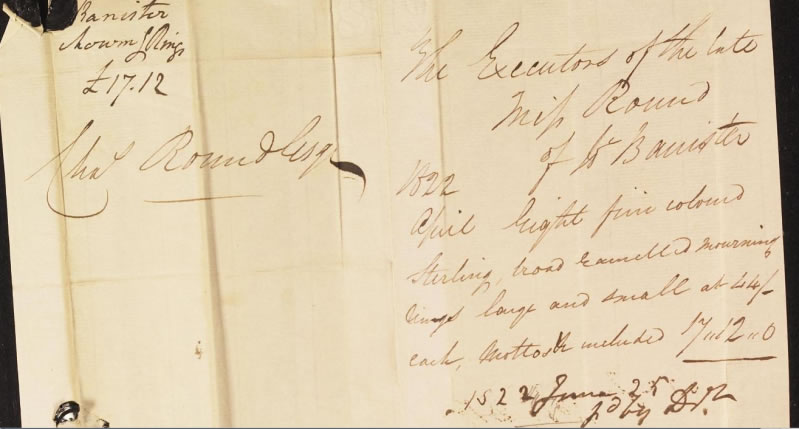 Eight April 1822
Chicago Ron is out there with his team videoing their finds as they are dug. I have uploaded a couple that are great fun to watch. I have a ton more great ones to upload yet.
Ron's bags his oldest ever coin silver video
Another Crispy Roman silver - in the 'cooker' to remove crust Mark Lehman has had a stab at the Roman silver ID below that has been 'cooking' for over a month, it is our oldest silver found so far on this site, circa 68 AD. I have put it straight back into the 'cooker' as there appears to be a lot more detail under the crust.
Roman 1st/2nd C silver coin as dug and 'cooking' to remove crust You probably won't be surprised that I'm not 100% certain on this one, but the obverse looks very like Vitellius - one of the 4 contestants for Nero's throne in 68 AD. Aside from Vespasian - who was the eventual victor - they're all scarce to rare. Vitellius is probably the least rare of the less common three (Galba, Otho & Vitellius), but it's still pretty unusual to encounter one of his denarii.
If I could just get some idea of what was supposed to be happening on the reverse in order that I could confirm that it's among Vitellius' reverse types, I'd probably be pretty certain, but I can't quite figure out what is going on with the reverse.
Mark
|
||||||||||||||||||||||||||||||||
26th March 2010 Cherub & ring treasures reported - Rare find donated - Mark's gold makes £2100 Ron's Saxon gold find vid I have just posted the 2nd half of the seasons 2011 dates on the site as members are booking over a year ahead now. Remember if slots are already full you can use the Barn self catering or hotel options. Another amazing medieval gold ring found by NS Andy that I have just reported to the museum as treasure. It is that twisted wire type and could even be Roman but it will now go off to the experts at the British museum for their evaluation. I have updated this years gold page which is a massive new record of 36 pieces of gold so far. I have also updated the hoard and treasure page with the latest finds now with the museum. I have uploaded a load more great finds and early hammered silver coins to the new hunt page March 2010 hunt page 2
Medieval twisted wire gold ring - no hall marks 22.34mm, 2.73g
Great result yesterday for the finder and landowner yesterday as Mark's Celtic gold coin find made £2100 at the Spink auction, 3 times the lower estimate.
Sale 1009 Lot 2 Celtic, early uninscribed coinage, (c.50-40 BC), AV Quarter-Stater, 1.12g, floral pattern on wreath, pellet in ring in centre, rev. horse running to right, curved ornament above, pellet in wheel ornament below (cf. BNJ 1998, coin register 14), extremely fine, very rare (approx.2-5 known) Ark Gary wishes to donate his rare Saxon saucer brooch find to Colchester museum, I spoke to the landowner this morning about the donation and he is in full agreement so it will end up there for all to enjoy.
5th-6th century AD Saxon gilded saucer brooch - running spiral design East Anglian type
Ill Mark found another 16thC cherub mount that I have reported as treasure. The other one found is Sept is currently going through the treasure process and has a confirmed date as Tudor. It is interesting to put the two along side each other as they are from different moulds.
16thC Tudor gold on silver cherub mount (left) - reported as treasure. Interesting to compare a similar example (right) we found in the first half of the season currently going through the treasure process.
Saxon lead gaming piece - black inlaid symbols - one for the museum experts
Cleaned up Ron's crisp medieval seal matrix, the impression appears to be two birds mating ? Legend *CREDE MICHI II
|
||||||||||||||||||||||||||||||||
24th March 2010 3rd Saxon coin day in a row - Stonking Elizabeth 1st gold - Celtic coin auction day I have created a new 2010 March II finds page to speed up load times
Ill John made it our 3 Saxon coin day in a row with our first Saxon silver from a new site. This coin was found 1/4 mile from the Saxon gold hoard so there could be more coins in the adjoining fields. Bavaria Terry had his best ever day and found 5 hammered silver coins of all periods from short cross to Elizabeth. He also got 2 stunning James 1st gold coin weights above so there is probably a fair site in this area. There are also some great silver relics being found, I particularly like the hallmarked decorated silver clog fastener.
Saxon C600 - 775 AD Silver Sceattas Porcupine Type - sent to Fritzwilliam museum for confirmation and recording Dr Martin Allen has send the ID back for the silver Saxon sceat reported yesterday Many thanks for this Series E (variety G3), which I have recorded as eMC 2010.0133. Martin Ill Mark is really kicking butt this trip and this is his 3 gold find of the trip with this stonking Elizabeth 1st gold half crown stunning coin taking our record total of gold finds this season to 35, updated this years gold page
1560-61 Elizabeth 1st gold half crown - mintmark cross crosslet - 0.994 fine gold 1.40g, 18.63mm Tomorrow is the Spink auction where Bil Mark and the landowner are slitting the proceeds of this rare Celtic gold find made in the first half of the season on his land. It will be fascinating to see what it fetches. Spink on line catalogue. I have a copy of the glossy catalogue and Mark's is on the first page and it looks really good.
Sale 1009 Lot 2 Celtic, early uninscribed coinage, (c.50-40 BC), AV Quarter-Stater, 1.12g, floral pattern on wreath, pellet in ring in centre, rev. horse running to right, curved ornament above, pellet in wheel ornament below (cf. BNJ 1998, coin register 14), extremely fine, very rare (approx.2-5 known)
1901 London hall marked solid silver thimble - interesting to note the thimble is perforated to keep the finger cool ?
18thc solid silver decorated clog fastener - PB over AB markers mark London and duty paid bust hall marks Peter & Ann Bateman PB/AB. 1791 - 1800 Bateman workshop at Bunhill Row London 1794
Huge Roman bronze animal head mount - possible bucket or vessel mount - looks like it is a bird with a hooked beak but it could also be an elephant 80.24g, 29.32mm L x 28.5mm dia |
||||||||||||||||||||||||||||||||
23rd March 2010 Saxon gold hoard found - Celtic gold ID'd - Shield matrix ID Thanks to Ian who has confirmed my ID of the earlier Celtic gold find and issued the coin a CCI (Celtic coin Index) number. If you find a Celtic coin, gold, silver or bronze in Britain record it with Ian at Ian Leins [ILEINS@thebritishmuseum.ac.uk]. 'Eastern uninscribed gold quarter stater of Dubnovellaunos, c 20 BC-AD 10. Van Arsdell VA1660 =BMC 2442. CCI number: 10.0874' Ian
CCI number: 10.0874' 1stC BC Celtic gold qtr stater - Eastern gold attributed to Dvbnovellaunos tribe Sent to CCI for recording 1.34g,11.67mm Hobbs 2442 Page 146 Colchester find
I have officially reported a potential Saxon hoard to Colchester museum as a 2nd gold coin was found by Ill John just 25 feet from the first one. I have recorded them both with Dr Martin Allen who runs the Early Medieval Corpus database at the Fitzmuseum , he has issued them with unique EMC numbers and sent me back the ID's below. Saxon gold are the rarest gold coins you can find in Britain so these are amazing discoveries. In seven years of detecting we have only found 3 so this now takes our total to 5. These two coins were not in my existing reference books as they are continental Saxon coins so I need to obtain two French publications, Martin supplied me the names of the two must have books below. M. Prou, Catalogue des monnaies françaises de la Bibliothèque Nationale. A. de Belfort, Description générale des monnaies mérovingiennes, 5 vols (Paris, 1882-95). Here is the ID of the first Saxon found 'Saxon' gold coins not in the reference books are usually Merovingian tremisses, and this coin (EMC 2010.0130) is no exception to this rule. Merovingian gold coins greatly outnumber Anglo-Saxon gold coins as finds in England. With thanks, Martin
Chicago Ron took a vid of John seconds after he dug it, it includes his gold dance which I will upload later
Merovingian tremissis of the 7th century 1.26g,15.08mm This coin (EMC 2010.0131) is a Merovingian tremissis of Coutances (dep. Keep looking. Martin
The history of Anglo-Saxon coinage spans more than five centuries, from the end of Roman rule in Britain in the fifth century, down to the death of Harold Godwinson at the Battle of Hastings on 14 October 1066. It can be divided into four basic phases:
In the gold phase of the coinage, the currency consisted overwhelmingly of gold tremisses or thrymsas of c. 1.10–1.30g, though a few solidi exist, modelled on Roman coins. Thereafter the currency was more or less based on a single denomination: the silver penny. In the early 870s the first round halfpennies were produced under Alfred the Great and Ceolwulf II of Mercia; these were produced sporadically and in small quantity until Edgar’s reform of the 970s, after which it became common to cut whole pennies into halves and quarters, often at the time of production. The only known examples of larger silver denominations are two ‘offering pieces’ produced in the reign of Alfred the Great weighing the equivalent of six regular pennies, which were made as alms-pieces, probably to be sent abroad. Although gold ceased to be the predominant form of currency in the seventh century, from the late eighth century onwards there was some use of fine gold coinage for special, high-value transactions. These gold pieces were often known as mancuses. The form of gold coinage varied in the eighth and ninth centuries, drawing inspiration from Roman, Byzantine, Arabic and Carolingian gold coinages, but by the tenth century gold coins were made simply by striking a gold piece with the same dies as were used for regular minting of silver. Only eight English gold coins with intelligible legends survive from between the eighth century and 1066; there are also some coins that may or may not be of English origin which bear no legend, and specimens of contemporary foreign gold found in England. It is difficult to ascertain the nature and extent of coin-use in Anglo-Saxon England. Written references to minting and money are scarce, and it is likely that even a single silver penny had considerable buying power – perhaps something in the region of £10–£30 in modern currency. Their use may also have been concentrated in certain classes of society, and was probably most associated with particular transactions such as the payment of rents, tributes and legal fees. However, analysis of surviving single-finds (principally made since the 1970s by users of metal-detectors) shows that coins were used extensively, especially in the eastern half of England, both within and outside towns; they also circulated widely, and are frequently found far from their mint of origin. Substantial numbers of English coins have been found elsewhere in Europe, especially in Italy and Scandinavia. Cal Jim is our official heraldic shield guy and has even in the past reunited a modern day family with their medieval Heraldic shield found by Van Brent. He has made a stab at ID'ing the stunning shield matrix below. I still have this find soaking in distilled water to remove the crud from the impression and it is getting almost good enough to get a good clay impression. NS Andy also found a crusty medieval quatrefoil pendant that I have been soaking for 2 days and slowly 4 enameled fleur de Lis are showing through, could be stunning if the centre enameling is still there. It is critical to use distilled water to clean bronze finds as it does not effect the colour or patina.
Ok, here is my best guess. Cal Jim |
||||||||||||||||||||||||||||||||
22nd March 2010 Find of the year? Saxon gold found - Another piece of gold
Amazing day, the landowner was out there chatting to the guys and they were showing him all their finds, a nice 68BC Roman silver, nice Elizabeth 1st shilling, some Roman bronzes then Ill Wendle who has been coming here for years walks up to us shaking and very excited. He takes out his small pill pot and drops this little puppy in my hand, the rarest gold coins you can find in Britain, Saxon gold. What a stunning find. I checked my ref books including Spinks and there is nothing in there like it. This is our 4th Saxon gold coin find and I have a feeling it is a 6th/8thC, Early Continental (Merovingian Francia), French Saxon gold. I have sent it off to Dr Martin Allen who is the Saxon expert and runs the Fitzmuseum Early Medieval Corpus National database where we record all our Saxon coins. He will be able to give us the definitive ID and record it with a unique EMC number. There were also some other excellent finds including our first ever heraldic medieval seal matrix with extra decoration on the 'bell' rim. Ill Mark found another piece of gold, neat Georgian brooch taking our record total of gold finds this season to 33, updated the gold page Updated my favourites for the find of the year award page I posted a load more great hammered silver and finds to the March 2010 hunt page.
c 600/800 AD Saxon gold coin send to Fizwilliam museum for ID and recording Not shown in any book I have ??? 1.35g, 13.87mm
Fantastic circa 13thC Medieval seal matrix with heraldic shield impression - this seal is first I have seen with additional decoration on the 'bell' top It will be interesting if we can find the family crest and who it belonged to
Georgian gold brooch - no hall marks but note the number 2 inscribed where the stone would have been
|
||||||||||||||||||||||||||||||||
20th March 2010 BC Republican silver and 11,000 BC axe - No hoard declared
Stunning unrecorded 5th Dragoon guards button Crimean war period
I had a meeting with Colchester museum yesterday to hand in all the Roman 'hoard coins' and treasures found so far in the 2nd half of the season. These will now go forward to the experts at the British museum for further evaluation .The potential hoard is now officially being classed as a 'scatter' and a village designation. Therefore the coins are no longer being classed as a hoard under the definition in the 'Treasure Act' which will mean the guys will eventually get their coins returned. The museum were given a map of the site and the locations of all the finds as this is an important discovery. I picked up the last of our recorded finds from the 1st half of the season that are now on the PAS database plus a couple of disclaimed treasure. I will post details later. The guys are making remarkable finds still and I have uploaded a bunch more to the March 2010 hunt page. I need to start a new March II page to improve loading times as the page it is getting too large. I was hoping the latest Roman republican silver find by Chicago Ron was going to beat our club record at 136BC but Mark Lehman's ID makes it modern at 76BC !!, great find and Ron's oldest coin find to date. I still have 3 other Roman silver coins 'cooking' to remove their crust, 2 of them have been cooking for a month now and progress is very slow as they have the hardest 'horn silver' growth I have ever come across.
Ark Gary's 11,000 BC flint hand axe
As dug uncleaned Roman 76BC BC Republican silver coin sent off for ID
Minimal 'cooking' to bring out detail
2.46g, 16.61mm
I found your denarius - and it is Republican, although fairly late Republican.
L. Rustias, 76 BC.
Obverse: Helmeted head of young Mars right - asterisk-like XVI in monogram below chin, SC behind.
Reverse: Ram standing right, L RVSTI in exergue - RRC 389/1, CRR 783, RSC-Babelon Rustia 1, SR 320.
It's a little unlikely, but not inconcievable that this coin was still in active circulation when Claudius invaded Britain - it certainly would have been current when Caesar made his ill-fated attempts. So it could have come either in pre-Roman trade, or during an early Roman incursion.
Neither particularly rare or particularly common - sort of an in-between type for scarcity.
Mark
As dug
Roman silver coin - cooking to remove unusual thick green crud
Roman 1st/2nd C silver coin as dug and 'cooking' to remove crust- You can see how thick this crust is on the lastest pictures of his bust
Well worn Roman BC period Republican silver coin - hopefully there is some detail under the crust after it is 'cooked'
Roman bronze bucket handle mount
|
||||||||||||||||||||||||||||||||
18th March 2010 More neat finds Loads more approved export licenses arrived this morning, list of names posted on the members forum. The guys are digging some really crisp hammered silver coins and Roman bronzes with great detail not photo'd yet. Still got loads of other great finds to post yet including Chicago Ron's BC Republican Roman silver coin find and another unbroken Roman fibular brooch. I will try and get more posted tomorrow but I have loads of paperwork to get out the way first and gather all the treasure finds together for drop off to the museum meeting. I have posted more finds to the March 2010 hunt page.
Solid silver dragon brooch - 1948 London hall mark
1427-30 Henry VI hammered silver groat - Rosette Mascle issue - Initial mark Cross Potonce - Cross 3a Rev VILLA CALISIE - Calais Mint
1435- 1438 Henry VI hammered silver penny - Cross 5 - Leaf Tefoil issue Rev VILLA CALISIE - Calais Mint
1341 Edward III hammered silver florin penny -Cross 3 Obv EDWAR ANGL DNS HYB Rev CIVI/TAS/LON/DON - London mint
Roman protected loop terret -(reigns guide)
|
||||||||||||||||||||||||||||||||
16th March 2010 Yet more great finds including Celtic bird Cleaned up the medieval seal matrix from a couple of days ago and took a clay impression, looks like an owl and the lettering is now easy to read.
Seal impression Legend *HELE . CVR . SEVLOVLE The guys are finding some great hammered silver groats including a rare Richard II example . Ill Joe found an amazing 1stC BC Celtic raven bird artifact used in sacrificial or religious ceremonies posted below. He also found a real nice Roman animal headed strap end. I have posted more finds to the March 2010 hunt page. Another real crusty Roman silver was found by Ill Mark and was put straight into the 'cooking' pot to remove the crud. I am still 'cooking' two Roman silver coins from 3 weeks ago and the crust is as hard as concrete.
Rare 1377- 1399 Richard II hammered silver groat - London - New bust wide hair Type 3 - curved serifs
Roman animal bronze decorated strap end - 2 rivet fixing
Fantastic find 1stC BC Celtic bucket mount - The bird probably a raven would be one of a series used as decoration around the top of the bucket. The bucket was used in sacrificial or religious ceremonies In Celtic mythology birds were represented as the messengers of the gods
34.02mm L, 5.28g
Excellent button find - 19thC GR 'Royal Waggon Train' The Royal Waggon Train (1802-1833) Within a month of being created, part of the Corps arrived in Holland but because of the Treasury involvement, the vehicle establishment of 100 bread waggons, 100 forage carts, 20 hospital waggons and 10 forge carts had not been constructed and even by the time this campaign ended, still nothing had been done. However, some good came out of this campaign in that it was generally acknowledged that an organised transport service was essential and that disciplined people accustomed to horses must be recruited. A pause in hostilities brought about by the Peace Treaty of Amiens in 1802 gave a short breathing space to the contending powers. By May the following year, Britain and France were again at war with France amassing an invasion army. Following Nelson's victory at Trafalgar, the French marched away from the Channel to fight their continental enemies. In 1807 they invaded the Iberian Peninsular determined to close all European ports to Britain. In 1808 Sir Arthur Wellesley sailed to seize the naval base at Lisbon. He took with him two troops of Irish Commissariat Waggon Corps. By October these two troops had been incorporated into the Royal Waggon Train, bringing the strength to twelve troops - a total strength of 2000 all ranks. Echelon duties in support of the Commissariat continued but now, where transport columns had to be protected, the Royal Waggon Train was increasingly involved in providing close support to the combat arms. It became normal practice to split the organisation into small detachments in direct support of infantry or cavalry. The landing in Portugal was to the north of Lisbon on the beaches at Mondego Bay. It took a while but it did give Wellesley the time to organise his logistic support in a way which was to become familiar during his campaigns. He was a master at solving logistical problems having learned his lesson whilst fighting in India. His task was to ensure "the final and absolute evacuation of the Peninsula by troops of France". Whitehall, however, maintained its ignorance of the logistics involved in a military campaign fought by an army over difficult terrain. Within a month of landing in Portugal, Wellesley gave the French a foretaste of the capabilities of the British Army by defeating them at Rolica and Vimeiro. The command of the British Army in the Peninsula during the winter campaign 1808-09 now passed to Sir John Moore, Wellesley having temporarily fallen out of favour for his involvement in the Treaty of Cintra which allowed the defeated French to sail home in British ships. In October 1808 a British force under the command of General Sir David Baird landed at Corunna followed a weeks later by three troops of the Royal Waggon Train. It was Moore's intention to hit the French lines of communication but he was forced to retire when he came up against Napoleon's army - a ratio of more than 6 to 1. His retreat was no easy matter as waggons provided from local resources broke down and the hired drivers deserted with their teams. Other waggons were too wide or inappropriate for the narrow roads. Additional horses had to be harnessed to pull these waggons thus reducing the overall number of supply waggons. The sprung waggons were used as ambulances with two men lying or eight men sitting. Morale and discipline of the troops began to suffer and storage depots set up by Baird were ransacked by Moore's retreating troops. This retreat ended with the Battle of Corunna in 1809 where Moore was mortally wounded. The Royal Waggon Train ended up being employed on mundane transport tasks and in 1815 was reduced to five troops and three years later to two before being disbanded in 1833. |
||||||||||||||||||||||||||||||||
15th March 2010 Another monster Saxon and Roman day
3 beauty Roman fibular brooches 1stC Colchester type two piece - 1stC Rosette brooch
What a staggering days detecting out there. Ark Gary popped a monster find, our first ever 5thC Saxon saucer brooch, near it was our 4th Roman fibular brooch of the day and then Cal Dan finds one of the best Roman silver coins I have ever seen dug. I thought it's condition suggested it might have been protected in a pot but Mark Lehman's ID below of the coin suggests it is avery high grade of Roman silver. Then Chicago Ron on the other end of the site digs a late Roman silver is great condition and then to cap it all Ill Mark pulls out the amazing enameled gold piece. I spoke briefly to the museum this morning and the suggestion is that could be medieval. On top of all these finds the guys pulled out some excellent hammered silver coins that I will be posting to the latest finds page March 2010 hunt page. I have also updated this season gold page and we now have a record 31 pieces so far.
Ancient gold ring bezel ? -cloisonné enamel-work - reported to museum as treasure 1.25g, 9.84mm dia
5th-6th century AD Saxon gilded saucer brooch - running spiral design East Anglian type
Best condition 2nd C Roman silver coin I have seen dug - sent for ID 2.89g, 18.95mm Of course, just as soon as I comment that you never seem to find any Severan Dynasty material, the very next coin you send me is right in the thick of the Severan Era. This denarius is of Caracalla - as a young man, obviously - he was elevated to the status of co-emperor alongside his father, Septimius Severus, at about the age of 10 in 198. This denarius, from the main mint at Rome, was struck c.203. The reverse type, VIRTUS AVGG, has Virtus (or Roma - it's somewhat ambiguous who was intended) standing left holding a small image of Victory and a spear.
(RIC IV 149, RSC 665a, SR 6903)
As for the condition - sure, I suppose it might have been in a pot which has only be broken open by agricultural action in very recent times. This is relatively good silver (maybe 50-60% or better) so would be far less liable to corrosion than silver heavily alloyed with copper and/or lead.
Quite the decent piece - not particularly scarce as these go, but a great find for you and your coin-shooters.
Mark
4thC House of Constantine Roman silver coin sent for ID 0.94g, 13.11mm
Although not Constantine himself, you're fairly close as to the era. In fact, we probably won't be able to say exactly who's on it, except that the reverse type, VIRTVS ROMANORVM with seated Roma holding globe and spear, wasn't used on silver siliquae until the time of Gratian and Valentinian II (378-383). If I'm reading the mint mark correctly - AQPS - it's from the mint at Aquileia - or possibly Milan - MDPS -
The style of the seated Roma is more in line with the end of the 4th century than the 380's - so I would hazard a guess that if we could read the obverse, it would be Arcadius or Honorius - c. 400 - the last two emperors in this era who used Aquilea or Milan.
So it's a siliqua, it has probably been clipped - possibly "officially" clipped to bring the weight into line with Saxon Sceatta. Minted around 400 AD, it was probably in use for something approaching to 2 or 3 hundred years thereafter, although more likely as a part of a store of wealth than as a circulating coin.
Mark
|
||||||||||||||||||||||||||||||||
13th March 2010 Staggering finds being made The guys are making the most unbelievable finds including including another dozen Roman hoard coins and crisp hammered silver coins. Bill Mark found our first ever Celtic gold qtr Dvbnovellaunos tribe. We have only full full staters of this 'Colchester tribe' before. I found a match in the Hobbs ref book and have sent it of to John Stills for recording on the CCI database and for his views on the die type. Ill Mark found the monster early Saxon 'dragon headed' silver strap end which has been reported to Colchester museum as treasure. This is only our 2nd ever silver Saxon period strap end, the previous example was silver sheet on bronze and disclaimed by the British museum as not being 10% silver by weight. This latest example appears to be solid silver. Other great finds include Can James who found 2 Saxon animal stirrup mounts 50 feet apart so they could be from the same rider. Then Ill John finds an ancient gold ingot that could be part of a Celtic ankle/wrist torc, one for the museum to play with as it has also been reported as treasure. I have posted a load more great finds to the March 2010 hunt page including a decorated Celtic cosmetic wode grinder.
Medieval seal matrix
7th century Saxon dragon headed silver strap end - reported as treasure to museum
35.89mm L, 2.61g
1stC BC Celtic gold qtr stater - Eastern gold attributed to Dvbnovellaunos tribe Sent to CCI for recording 1.34g,11.67mm Hobbs 2442 Page 146 Colchester find
2 - Late Saxon c10thC stirrup strap mount Class A Type 11a Sub triangular mount depicts a Lion looking upwards with its front paw raised and tail curled between its legs and over the back
Ancient gold ingot - possible wrist or ankle torc fragment 3.48g, 3.45mm dia , 29.86mm L- reported as treasure to museum |
||||||||||||||||||||||||||||||||
10th March 2010 More stonking finds. Mitch Chris is on fire this trip with that stunning Roman gold ring find and now really nice condition Roman silver coin that Mark Lehman has sent his views on below. Nice to find a coin without a thick 'horn' crust to cook off. We are slowly getting around the new 66 field site and it has all the periods, Chris pulled up a mint seal matrix and the first lead Pilgrim's ampulla from this site below. More great finds and hammered silver posted to the March 2010 hunt page
Great condition Roman silver coin - minimal cleaning 2.80g, 17.48mm
This is a denarius of Marcus Aurelius as Caesar under Antoninus Pius. Do you notice you've been finding a LOT of Antonine-era and Constantinian-era material - and very little Severan or late 3rd century material? It seems this site must have had a couple of population or activity peaks - one in the mid 2nd century and one in the early-mid 4th century. There seems to be a gap - at least in the coins you're finding - of a century and a half to two centuries. That's if this all has been coming from the same site, of course.
The obverse legend is AVRELIVS CAESAR AVG PII F, M. Aurelius' bare head right. The reverse reads (I believe) COS II - meaning that he's now in the office of consul (sort of like "President" or "Prime Minister") for the second time - since all we can see is "CO...II" it might also be COS DES II meaning elected but not yet inaugurated - making a difference of a couple months and placing it in the previous year (144.) The device is Honos standing left holding a branch and a cornucopia - this type is known for both COS II & COS DES II. As far as I can tell, this is a product of the mint at Rome in AD 145 (but maybe 144).
Mark
Good call by Mass Linda on a Roman tendril pendant she found last week in the Laycock book Fig A14.7
Mass Steve's 18 Roman hoard coins sent for ID # 25 appears to be a Dupondius of the Antonine Era - I believe I see the points of a radiate crown on the portrait, the size and weight are consistant with dupondii of that era. Most likely Antoninus Pius (138-161) - the reverse is too far gone to say more than that it's a standing figure - the reverse legend seems to end in "...COS III" dating it, most likely, to the time of Antoninus' 3rd consulship, 140-145 AD. It might be COS III, however, in which case, it would date it from 145-161.
#23 & # 24 are both Constantinian-era pieces, both Folles -
on # 23 I can make out "...CONSTAN..." on the obverse and not very much else - I can't figure out what the reverse is doing - 4 members of the Constantine clan are potential suspects (Constantine I & II, Constans & Constantius II) - without knowing the reverse type, I can only estimate a date roughly, say 315-325 AD.
# 24 has a little more going for it, I'm pretty certain that it's Constantine I, and since the reverse type is one of the IOVI CONSERVATORI series of reverses with Jupiter standing left, holding a small figure of Victory, on a piece of this size, you can say approximately 313-318 AD. with some confidence.
Mark
|
||||||||||||||||||||||||||||||||
9th March 2010 More hoards coins and Roman pottery - Extending the season to end of April
The gold inscribed ring find from a couple of days ago is confirmed as Roman, the script on the inside of the ring is Roman writing, great find. The new 66 field site is producing just amazing finds and it has just about every type of crop out there. There is freshly ploughed and rolled, wheat, leaf vegetables, stubble, pasture so there will be tons of detectable land well past our normal season finishing time on the first week in April. If there is sufficient interest them I will extend this season to the end of April. Remember we can only search this land out of animal hunting season from Feb 1st to April each season. Drop me a mail if you want to join a new team for the last 3 weeks of April. I have been chatting to the Head guy at the British Museum that makes the decision as to whether all the recent potential Roman hoard coins will be officially declared a hoard. I have forwarded him all the other Roman artifact pictures, fibular, brooches, bracelets etc and a selection of the Roman pottery below to aid his decision whether this will be declared a hoard, votive offering site or village. I have one more bag of hoard coins to process yet and have posted Mass Linda's 19 coin finds below with some of the ID's from Mark Lehman. Special thanks to Mark for his brilliant expertise at ID'ing the finds which give us a date spread of 180 to 360 AD so far. Mass Linda also found a particularly nice Roman decorated spindle whorl looking find, first for us. I have posted a load more widgets and silver to the latest finds page March 2010 hunt page
Roman bronze decorated spindle whorl
Tenn Brad sent me a picture of a 14thC John the Baptist medallion found in the river Thames and it matches exactly the pendant found by Bil Mark on the Roman hoard field, great find.
6 inch long chunks of Roman pottery, they include rims, bowls and tiles Working my way through the hoard coins and sending them off to Colchester museum. I have also photo 'd some of the huge chunks of Roman pottery found, Mass linda picked up a huge bag of them that will also go off to the museum for their views.
Mass Linda's Roman hoard coins
Coin 20 (Mid 3rdC)-------------------------------------------------------- Coin 21 (350-353AD)
The piece with the short altar on the reverse is a BEATA TRANQVILLITAS - these date to about 320, they're the series just after the VLPP's. It seems to say CONSTANTINE on the obverse, but could be either Constantine I or son Constantine II, I can't see the end of the legend and that would tell us whether it was Constantine I (AVG), or II (NOB C) - The letters in the field - C - R on either side of the altar allow me to attribute it to the mint of Lugdunum (Lyons). - here's an example of a similar type from the mint of London - http://www.stoa.org/gallery/album164/34_Constantine_II_BET_LON
Coin 22 (330-337 AD) Roman coins sent off for ID
Roman coins sent off for ID Coin # 20 appears to be a contemporary copy of a mid-3rd century antoninianus. Some folks call these "Barbarous Radiates", although I think that's a completely inappropriate name and mindlessly continues the narrow-minded artistic prejudices of our Victorian forbears. The folks who made and used these coins were no more barbarians than were the makers and users of the coins which they copied - in fact, they tended to be the most civilized residents of an area. These coins typically were an "emergency currency", not unlike Conder Tokens or US Civil War or Hard Times Tokens. When no official coin is reaching an area the economy of which is normally facilitated by commonplace use of coinage, local substitutes - usually in imitation of familiar types - almost inevitably arise. These pieces were not made to decieve, (and so are NOT "counterfeits"), rather to take the place of Regal Coinage which had become unavailable due to hoarding and/or attrition.
This piece is not in good enough condition for me to be sure what was being copied, although the "PAX AVG" and "SPES AVG" reverse types were overwhelmingly popular on 3rd century contemporary copies and the standing figure's raised arm might be holding an olive-branch or a flower. It appears from the seeming string of "O's" in lieu of legend visible around 1:00-4:00 on the reverse, that this may be a contemporary copy of a Roman type by an illiterate or semi-literate neighboring group - it was common for legends to be reduced to a design element when coins were copied for this purpose - as a supply of coins for trade purposes to semi-Romanized local peoples who had become familiar with the use of coin.
Date this one to approximately 265-275 AD.
Coin # 21 seems to be of a 4th century Caesar. It was common at that time to distinguish between emperors and Caesars by the headgear on their coin portraits. This is a bare-headed bust, and so you'd think it must be a Caesar. However, the legend ends in "...AVG", and there is one Augustus who often appears bare-headed, Magnentius. So my best guess on this one is a Centenionalis of Magnentius with a FELICITAS REIPVBLICAE reverse type - the emperor standing left, holding a small figure of Victory and a labarum. Magnentius was around for only a brief time, 350-353 AD.
Coin # 22 is a "City Commemorative" - when Constantine moved his capital to Constantinople c. 330, there was a very large issue of small folles commemorating both Constantinople and Rome. This is an VRBS ROMA - with helmeted Roma facing left on the obverse and the mythic Shewolf standing left on the reverse suckling Romulus and Remus. These belong to the period 330-337 or so.
None of these has any legible mint marks (not that the mint mark would mean anything on the contemporary copy) so I can't tell where they were minted.
Mark
|
||||||||||||||||||||||||||||||||
7th March 2010 Monster gold find - More hoard coins and hammered silver
Stunning 1st C decorated fibular brooch The new team in yesterday have started really well 7 hammered silver coins and another mint fibular brooch on a new field, the only Roman coin found was beat to death. Mitch Chris made another monster find with what I initially thought was a Roman gold ring but the legend has me baffled. The double legend on the inside of the ring is perfectly legible but makes no obvious sense, I do not recognise the type of script and is it is definitely not of medieval Lombardic script type. No idea if the Saxons made rings like this so it definatly one for the museum. I have just reported it as treasure and I will find out what the local FLO's views are hopefully on Monday. Started a new finds page to speed up load times March 2010 hunt page, uploaded more great hammered silver and more Roman widgets Updated this seasons gold find page Updated the hoard and treasure page
Stunning Black and white enameled gold ring - double banded with inscription on both upper and lower bands.5.83g, 25.91mm L x 8.40mm W Top legend -LEI TRVTEE ADVANCE Bottom legend - ECHE . FORTVNES CHAVNG
I am slowly going through last weeks Roman hoard finds and sending them off to Mark Lehman for his views. The Batch below were the ones Boston Beau found and Mark has ID's the examples with any detail showing. Beau said the Maximian bronze he found with great detail was in black clay type soil which appears to have protected it better than the other 'grots'. Date spread so far is from 138 to 360 AD. I have a couple more guys 'hoard coins' to process yet to see what the actual date spread is.
Boston Beau's Roman hoard coins
Roman bronze sent for ID 3.48g, 25.88mm
The larger one with good detail (#8) is pretty easy - that's Maximian, Diocletian's partner in founding the first Tetrarchy at the end of the 3rd century. It's a Follis, and the type is "GENIO POP ROM" - the "Genius" (meaning more like "spirit" than anything to do with MENSA) of the Roman People. This is an interesting type - it's about the only follis of this kind with no mint mark - which means, in this case, it's from the mint of London, c. 300-303.
#9 seems to have the legend "GLORIA ROMANORVM" - which should be a big help, except that this legend is used over and over by many rulers over centuries. Checking a particularly helpful on-line reference, I find that if the design is what I think it is -
"Emperor on horseback, galloping right, spearing barbarian with outstretched arms kneeling left beneath or in front of the horse; shield and broken spear beneath horse" - here's a none-too-clear example from my collection: http://www.stoa.org/gallery/album167/28_Magnentius_GLO_AQL
- and about all I have to go on for certain is the shield at the bottom, the fact that's it's a "busy" design, and the mint mark - "TRP" (Trier mint) - with this legend, if it is this type, it can only be Magnentius - a short-lived emperor in the 350's, promoted from general to the purple in the field by his troops - the last hoard you had was deep in Magnentius and his brother Decentius. His legitimacy as an emperor and popular support was mainly centered in the Western part of the Empire.
#10 is just a face - unfortunately, as nicely crafted as this example is, by the end of the 3rd century, the "photo-realism" of earlier centuries was gone. Now, the engravers were generally struggling to make the obverse portrait look like "a person" - unfortunately, not a specific person, just a more or less generic human, so except for a few notable exceptions, you just can't tell who was intended if there's no legend, no reverse, etc. The fact that the headgear is a laurel-wreath instead of a diadem places it at least before the death of Constantine I (337) when the imperial diadem completely replaced the laurels of an earlier age.
Mark |
||||||||||||||||||||||||||||||||
6th March 2010 Another 40 + Roman hoard coins found and a Roman gold ring I think the guys have discovered a large Roman village on this new 66 field site as it produced another 40 + Roman bronze coins and the first Roman silver coin from this hoard. The bronze coins have a good date spread, several are 1st/2ndC examples that at our Roman expert has ID'd already . It will take me quite a while to work through the finds as the area also produced a wealth of other periods I have yet to photo. There are multiple finders of this hoard so I have to prepare the report by finder to supply this information to the museum. Mass Steve found an exciting Roman gold ring from a different area on the site and this has been reported to the museum as treasure.
Just posted a load more Roman finds and hammered silver to the latest hunt page Feb 2010 finds
Mass Gary's hoard coins
1stC Roman bronzes with detail sent off for ID Sestertius of Commodus, son of Marcus Aurelius, (177-192) ---------------- As or Dupondius of Faustina II, wife of Marcus Aurelius,
Roman silver coin sent off for ID Antoninus Pius (138-161) The denarius seems to be Antoninus Pius (138-161), I'm not certain about the reverse type yet, but it might be a Fortuna type, I seem to make out "FORTVNA" on the left. Antoninus was a prolific producer of types, we'll need to be able to read at least a few letters of the legend on the reverse to be more sure.
"#6" is a sestertius of Commodus, son of Marcus Aurelius, (177-192) the reverse appears to be Salus - what you don't see is the branch she's holding out over a serpent rising at her feet.
"#7" appears to be an As or Dupondius of Faustina II, wife of Marcus Aurelius, All I have to go on, to distinguish between her, Lucilla and Crispina is the solitary "F" at 7:00 obverse, which seems to be all that remains of the obverse legend. I'm afraid that with a coin so compromised, it's not easy to be certain, but my best guess is Faustina the Younger.
Mark
Boston Beau's Roman hoard coins
Roman bronze sent for ID 3.48g, 25.88mm
Romano/British Ancient gold ring - reported as treasure to the museum 1.53g, 26.17g |
||||||||||||||||||||||||||||||||
5th March 2010 Potential Roman hoard found - More great finds posted I have posted more finds to the latest hunt page Feb 2010 finds. Late in the evening the guys came across an area of a new field and found around 15 Roman bronze coins plus a bunch of Roman bronze pieces including a mint complete 1stC fibular brooch. The Roman 'Weisenau type' helmet handle was another great find from the same. Over 10 bronzes in an area constitutes a potential hoard so I have reported them to Colchester museum and the landowner. I sent them off to Mark Lehman for his views and ID's which are posted below. The date spread of the coins is 315 to 360 AD so it will be up to the British museum experts to determine is this a hoard or a village location and scattered casual loss over time. The guys only searched this huge field briefly will be returning to that area at a later date to see if there are more out there. Hopefully there are some silver examples or even gold coins lurking.
4thC Roman bronze coins
The piece with the short altar on the reverse is a BEATA TRANQVILLITAS - these date to about 320, they're the series just after the VLPP's. It seems to say CONSTANTINE on the obverse, but could be either Constantine I or son Constantine II, I can't see the end of the legend and that would tell us whether it was Constantine I (AVG), or II (NOB C) - The letters in the field - C - R on either side of the altar allow me to attribute it to the mint of Lugdunum (Lyons). - here's an example of a similar type from the mint of London - http://www.stoa.org/gallery/album164/34_Constantine_II_BET_LON
The other piece with a clear reverse is another 1-standard GLORIA EXERCITVS - I can make out "...STANT..." on the obverse, which rules out only Constans and Delmatius - it could be any other member of the Constantine clan - and again, I can't see the end of the legend which would allow me to narrow it down between a Caesar or an Augustus. (Pretty much the same list in either case, since all 3 of Constantine's sons became Augustii on his death in 337 - all 3 had been Caesars previously).
The piece for which you sent only the obverse image has no visible legend, but the portrait tends to look the way Constantius II tended to be portrayed on his FEL TEMP REPARATIO (soldier spearing fallen horseman - I'm sure you're familiar with these - they're probably the most common coin-type of all antiquity). You must understand, this is 90% guesswork when I'm seeing only an obverse portrait of this era with no legend and no part of the reverse.
So far, with the exception of the larger pieces you sent yesterday, just about all this material dates to the Constantinian era - but over a fairly broad span of years, say 315-360. This is a little later than most of the coins you've shown me from your other, earlier dig-sites, although your last "hoard" of Magnentius/Decentius Centenionales came from a specific bit of the same general era.
Mark
the "D" shaped one (# 5, I believe) is a GLORIA EXERCITVS - "(to the) Glory of the Armies" - with a single standard between the 2 soldiers, it dates to the period 335-340. They were struck for the entire Constantine clan and a couple cousins, besides, so without some pretty clear letters on the obverse, it's difficult to tell who was intended to be portrayed. I can, I think, make out the bottom seriphs of "...AVG" at the end of the legend, so that narrows it down to 4 possible suspects - Constantine I & II, Constans and Constantius II - with no real way to tell who it is.
This one might have looked something like this, originally - http://www.stoa.org/gallery/album165/67_Constantine_I_GE1_ANT
The very irregularly shaped one (# 4, I think) dates to around 320 AD - these were struck for Constantine I, his oldest son Crispus, and the two Licinii. These are known as "VLPP's" - the reverse (VICTORIAE LAETAE PRINC PERP) shows 2 Victories, face to face, resting a shield inscribed "VOT / XX" on a short altar. I'm pretty sure this one shows Constantine I - or at least that's what the fragments of legend between about 8:00 & 12:00 on the obverse lead me to believe.
It would have looked like this, originally - http://www.stoa.org/gallery/album164/02_Constantine_I_VLLP_TIC - although the bust faces the opposite direction.
There isn't enough of their lower reverses visible to tell which mint they might have come from.
Mark
13.14g, 50.51mm
1stC AD Weisenau type helmet - they have the distinctive carrying handle on the neck guard
Roman helmet handle 14.08g, 87.42mm L Ref Laycock Page 35 Fig AA.4.7
I managed to get some detail on the Obv of the Roman coin found a couple of days ago, Mark Lehman's updated ID is below
Antoninus Pius (138-161 AD)
Antoninus Pius (138-161 AD) AE As, 26mm, 10.50gm, BRITANNIA COS III; SC (in ex). Britannia seated left on rock in attitude of dejection, chin propped on right hand and left hand resting on rock; in background, shield and vexillum. RIC II 934, SR 4296, VM 119.
These are not "rare", or even really scarce, but they tend to sell for much more than comparable contemporary pieces due to the Britannia reverse. This design was struck on all of Antoninus' AE denominations and the sestertii can be quite pricey - particularly if they're in nice condition.
There is also a Britannia reverse from Hadrian's "grand tour" series, but those are rare - and very expensive.
I'll get back to you when I've had a chance to analyze the photos you attached to today's mail.
Mark
|
||||||||||||||||||||||||||||||||
3rd March 2010 More treasures - top 10 finds Great article link below 'Here we round up 10 of the top artifacts discovered by metal detector in Britain'. Top 10 Metal Detector Discoveries Great story Man discovers treasures in wife's handbag
Stunning 16th/17thC decorated silver bodkin needle - reported as treasure to Colchester museum 2.79g, 70.64mm L
Medieval seal matrix Anonymous: letter I early 15thC. An initial with crown above, branches at the side, was a design that became increasingly common in the 15thC and was often used on a signet ring as below. The letter suggests it stood for the owners forename. This example was used in 1424 by Edward Saddler, clerk
The guys are making more excellent finds and Mass Steve found a stunning decorated silver Bodkin needle treasure. Every field on the new 66 field site has produced Roman bronze coins so far but 99% are just 'grots' and eaten to death and illegible. However Steve found two with great detail that I am using the 'distilled water' method to soak and clean. Our Roman coin expert mark Lehman put me on to this method as distilled water does not effect the patina of the bronze in any way. They are still soaking to remove the remaining crud and I sent them off to Mark who gave his initial ID below.
.
As dug and soaking to remove crud The larger of the two is Faustina the Elder - wife of Antoninus Pius. She did her duty as a Roman matron and popped-out a lot of Imperial larvae, then (conveniently for him, it would seem - although we have no evidence of him taking any advantage of his most-eligible-bachelor status) she died in 141 AD, only 3 years after Antoninus donned the purple. Among her daughters was Faustina the Younger, wife of Antoninus' successor, Marcus Aurelius. This coin was part of the relatively huge posthumous coinage Antoninus minted in her honor throughout his long reign (138-161). The reverse shows Juno standing left, holding a patera and resting on a scepter.
The smaller piece, an As it would appear, is Antoninus Pius - other than what I think is a pair of legs - indicating a standing character of some sort - I'm afraid I can't make sense of the reverse from the photo - if it is cleaned any further, or you can get a photo which makes whatever detail there may be seem more clearly visible, I can give you at least a guess as to what the reverse type might be.
Mark
Great to find new 17thC trade farthings to add to our set. I have updated the hammered copper finds page I have posted more finds to the latest hunt page Feb 2010 finds. Updated the hoard and treasure page with our latest treasures
'There was also a dire shortage of coins of small denominations, such as a housewife needed for everyday shopping, a problem that had been increasing since James I’s day. The few copper farthings produced were all under license to various nobles, and the supply of them was not sufficient to fill the demand. Shopkeepers evolved a pragmatic solution: trade tokens. In the 1660’s there were 3,543 ‘tokeners’ in the City of London, its suburbs and Westminster. These tokens were usually made of lead, tin or copper, although some were of leather. They were usually worth a halfpenny or farthing (only the coffee-houses found it worthwhile to issue 1 penny tokens). They were small and came in a variety of shapes – round, heart-shaped, diamond, square or hexagonal. Shopkeepers kept boxes with compartments for each issuer (usually only for those tokeners in the same area, not all 3,543!) When they had enough they returned them to the issuer, who changed them for silver or notes of hand. In March 1668, Prince Rupert and the Duke of Norfolk suggested to the King that they should make ‘current farthings’ to prevent ‘the loss and inconvenience by private tokens in case of removals etc., as appeared in the late Fire of London.’ However, it was not until 1672 the mint started issuing the first copper farthings. The following references may be of help if readers wish to pursue the interest further:'
|
||||||||||||||||||||||||||||||||
2nd March 2010 Beau's double gold day and excellent relics - New Barn 4
More details on the New Barn IIII Min Mindy has found another brand new 4 star self catering converted 'Barn IIII' locally for the club to use and she has been e-mailing the owner. I went and saw it yesterday and it is a huge place sleeping up to 11 guys and in immaculate condition with beautiful wood floors and all the mod con's including on suite bathrooms. It has 8 proper beds and additional sofa beds in a second galleried lounge. These converted barns are really smart as they keep the character with old beams and wood floors. Mindy is running 2 Barn events in the fall of 2010 and has now transferred her 2nd trip to this new Barn so she will be the first to trial it for the club. That now gives the members a choice of 4 'Barns' to choose from with varying locations, sizes and amenities.
Boston Beau finds double gold
16th/17thC gold ring - no hall marks 1.75g, 18.51mm dia - reported to Colchester museum as treasure
Ancient gold ingot - 0.76g, 10.76mm long Thick chunk of ancient gold - reported to Colchester museum as treasure
The guys trialing New Barn II love the accommodation and the fact it is 3 minutes away from the new 66 field site. They have been getting on the new site by 7am and hunting well into late evening with their night lights. They have been finding the whole raft of periods again including Saxon and Boston Beau did the double gold finds from the same area. The chunk of ancient gold is interesting as the rest of what it broke off might still be out there. Updated the gold finds so far this season page.
Very interesting gilded Roman bronze piece - one for the museum
I have started to post the finds to the latest hunt page Feb 2010 finds. This gilded Roman piece above is very interesting and ornate, no idea what it is off so one for the museum to look at. I picked up the last batch of fixed hammered coins from the gold smith yesterday and will be posting results later.
|
||||||||||||||||||||||||||||||||
28th Feb 2010 More fixed hams - Hunts commence again - New Barn III I went and saw another new Barn type accommodation locally that guys can use as a self catering base. It is under a mile from our main sites and offers excellent accommodation inside and each bedroom has an on suite. It sleeps 6 max so is great for small teams with their own vehicle to roam as they please. Remember on these tours you can hunt any of the 300 fields you choose and be out there for as many hours as your arm holds up.
3 bed roomed Barn III added to our accommodation choices
The 'New Barn II ' team arrived yesterday to be the 2nd group of guys to search the new 66 field site with a totally fresh approach. Mass Linda is armed with her extensive research and old maps and there are an amazing number of historical plots from the records she sent me. She has plotted all the Roman dykes, enclosures, ring ditches, roads, villages etc on the site so it will fascinating to see what fields they pick to search and manage to uncover this week. Both Mass Linda and Can Rod our club historian come here armed with a huge history folders to determine where they search, other teams just wander aimlessly as the mood take them. With a site this massive it needs constant nibbling by different teams with different styles to try and hot spot it. This team have their own hire car and can just roam the fields as they fancy. They can spend all week on just one field or try and get around all of them. Remember if you are staying at the Barn you can also have full access to any of our other 250 fields. It could be a very interesting week as they could end up with just a musket ball and a handful of coppers or find the Viking/Saxon battlefield that happened in this area. More finds posted to the latest finds page Feb 2010 finds.
More of our fixed coins below and I am picking up another repaired batch today. The goldsmith rang me and two of the really bent crispy hammered silver broke during the annealing phase and he has silver soldered them back together. The last short cross he repaired with the method looked excellent so it will be interesting to see the results.
|
||||||||||||||||||||||||||||||||
23rd Feb 2010 More museum recordings - more fixed coins Updated the Charles and James hammered silver pages with this seasons finds so far. Updated the Anne milled silver page. I have have a bunch more finds to upload to the latest finds page yet Feb 2010 finds.
Fixed 1603 James 1st hammered silver sixpence - as dug, annealed, cleaned
Fixed 1573 Elizabeth 1st hammered silver sixpence - as dug, annealed, cleaned Posted a few more of our museum recording and ID's below. Interesting that the arrow shaped relic is ID'd as a Roman buckle plate. I am still cooking the Roman silver coin finds from last week and the 'horn silver' crust is rock hard but is dissolving very slowly. On the obverse picture you can clearly see the thickness of the crust.
Roman 1st/2nd C silver coin as dug and 'cooking' to remove crust
ESSEX, England: ESS-329A40, Roman copper alloy buckle plate
ESSEX, England: ESS-324C56, Medieval or Post-Medieval copper alloy IHS mount
ESSEX, England: ESS-31EFF6, copper alloy Medieval / early Post-Medieval mount
|
||||||||||||||||||||||||||||||||
22nd Feb 2010 New Celtic tribe for us - more finds and ID's Archived July 09 to Oct 09 Latest News to a new page to improve loading times of this page July 2009 to Oct 2009
Lead trade weights- Roman to medieval I still have a bunch of finds from last week to post yet and this group of large lead weights were all from the same area. The triangular shaped trade weight is the first medieval chevroned type we have found. It weights 1/2 pound (8 oz) and is 57.4 mm high . We have found a couple of the small medieval shield type coin weights before but not a full sized trade weight version. The other trade weights in this group are Roman and medieval so the guys have found the site of a market. There were also several of the 'steelyard' hanging type weights found in the same area. Well worth a return visit to that area. More find posted to the latest finds page Feb 2010 finds.
Celtic gold qtr stater 13.56,1.29mm CCI record 10.2000 'Heybridge Horse' type
It is not surprising that I could not find NH Dave's Celtic gold coin find in my reference books as it is not in there. John Stills from the CCI has just recorded the coin on the National database for us and his ID makes it is a new type for us and a rare one. I did not know there is a 'Heybridge Horse' type. Excellent find from new land. That is our 77th Celtic gold coin find since we started and they can be viewed on our searchable database at Foundintheground.com. http://foundintheground.com/search/SearchResults.aspx?q=celtic+gold 'Your latest quarter is the 'Heybridge Horse' type, not in VA or any of the other catalogues as you say. There are eight others known of the standard type with a pellet below the horse plus a unique variety with a spiral below. All the known finds are from Essex so it's almost certainly a Trinovantian issue that probably circulated alongside late Whaddon Chase staters of VA 1498-1502 type to judge from the very similar horse; datewise probably struck somewhere in the 40s BC. Here are a couple more from the last batch of our recorded finds now on the PAS National finds database.
ESSEX, England: ESS-2FEDC3, Post-Medieval copper alloy ?book clasp
ESSEX, England: ESS-3044A4, Medieval lead seal matrix
ESSEX, England: ESS-31B327, Medieval copper alloy harness pendant
|
||||||||||||||||||||||||||||||||
21st Feb 2010 Guys go home- more museum recordings and treasures
Is this the field where Richard III lost his kingdom for a horse? Real location of Battle of Bosworth finally revealed after 500 years
Fixed groat from our goldsmith 1464/5 Edward IV hammered silver groat - quatrefoils by neck - Fleurs on cusps except over crown- Rose mintmark - Standard Type F Rev CIVI/TAS/LON/DON - London mint The latest batch of coins sent for fixing is ready for pick, still got to post a few of the last batch yet.
17thC Charles II silver button - reported as treasure to Colchester museum
Medieval gold finger ring - reported as treasure to Colchester museum 1.71g,15.40g
The guys have finished their hunt and what an interesting first week on the new 66 field site. The weather was great and the guys just roamed around aimlessly hoping for a hot spot and found some amazing relics and coins. It is going to take us years to get a real feel of fields this large but it is showing huge potential. Two more treasures were found, Ohio Scott found a woman's plain medieval finger ring, Ohio Gerry found the 17thC Charles II wedding commemorative silver button, both have been reported to Colchester museum and the landowner. The silver Roman coins found during the tour have an incredibly hard crust and are still 'cooking' to break it down. I still have bunch of finds to post yet to the latest finds page Feb 2010 finds. This is our best ever season so far for gold finds since we started and I have Updated this years gold finds page The next hunt in is the Boston Beau team on the 27th Feb who are trialing 2 of the lodges at the new Barn II accommodation. The first guys loved the accommodation but one of the beds was a bit hard. There is one double bedded lodge free if anyone wants to join the hunt and it is only one mile from the new site. On this trip you have you own car, pick your own fields and can detect as many hours as you like with nightlight's if you fancy real hard core. The next full board hunts start on the 6th March for a month, hopefully we can get on each of the 66 fields on the new site before the close of the season in April. I have posted a few more of our PAS database entries below and their ID's.
ESSEX, England: ESS-32C082, Post-Medieval combination lock
ESSEX, England: ESS-2D16B4, silver Roman Republican denarius serratus of the moneyer Q. Antonius Balbus
ESSEX, England: ESS-2DFDE2, Medieval copper alloy jetton of Edward II
|
||||||||||||||||||||||||||||||||
18th Feb 2010 Monster double gold day - museum recordings I picked up another batch of our recorded finds from the museum yesterday and there are some very interesting ID's on finds we were not certain about. I have posted a couple below them with their National database entries and ref number. I will be posting more over the the next couple of days. Detecting is an amazing hobby. One day pouring down with rain, boot sticking mud, cold, wet and getting totally skunked. Next day bright sunshine, perfect land conditions and monster finds. They don't get any better than NH Dave's first very unusual Celtic gold from a new site to get the blood pumping. I just sent pictures and details of to the new landowner so he will be pleased with the finds so far. I cannot find a match in the Hobbs ref book but at a guess it could be a 50BC uninscribed QC qtr stater. I have sent it off to John Stills who runs the Celtic Coin Index National database to record it and get his views and ID. Then to make a great day even better Min Mindy finds another couple of stonkers, gold mourning ring and a huge medieval key in perfect shape. The guys also dug quite a few 1st/2ndC Roman bronze coins but they were all eaten to death apart from one that might have some detail after it has soaked for a while. Updated this years gold finds page I have posted more finds to the new hunt page Feb 2010 finds.
Celtic gold qtr stater 13.56,1.29mm - not sure of tribe yet, sent to Celtic coin index for recording and ID
(not treasure as it is under 300 years old) 1726 gold mourning ring - Legend with black enamel reads TIM COOKE 1726 AGE 73 2.07g, 20.34mm dia
Huge medieval key 76.34mm
ESSEX, England: ESS-32F9F1, Medieval copper alloy spur buckle
ESSEX, England: ESS-332F71, Roman copper alloy escutcheon
|
||||||||||||||||||||||||||||||||
16th Feb 2010 More early finds
Our new 66 field site has so far produced every period of find from 11,000 BC, Romano/Celtic, Saxon, Medeival up to present day. The latest find by NH day of a 1000BC socketed axe fragment means there was also Bronze Age occupation . This is an unusual find as it is the top section of the axe with the tie loop showing. Normally with axe fragments we find are the the botton blade section where it fractured. I have posted more finds to the new hunt page Feb 2010 finds.
1000 BC Bronze age socketed axe fragment - Mass Bruce's 850 BC axe hoard find
Interesting finds c10thC - 2 Saxon harness cheek pieces from the same field and they appear to be from the same maker
Roman 1sr/2nd C silver coin as dug and 'cooking' to remove crust
Well worn Roman BC period Republican silver coin - hopefully there is some detail under the crust after it is 'cooked'
|
||||||||||||||||||||||||||||||||
12th Feb 2010 Fantastic start to the hunts - 11,000 BC and a treasure
1413 -22 Henry V hammered silver halfpenny - broken annulets by crown - earl hair - Type 5 Obv HENRIC REX ANGL Rev CIVI/TAS/LON/DON - London mint 0.42g, 13.57mm What an amazing assortment of finds from all periods being discovered by the guys. The first treasure off new land found by Ark Gary is a stunning silver snake handle. It is difficult to date exactly as it came off an area where Min Mindy eye balled a 11,000 BC flint hand axe, BC "Romano-Celitberian"bronze coin, 200 AD Roman coin , Saxon and medieval finds. I have started a new hunt page Feb 2010 finds and started to upload the hammered silver and relics to it.
Possible Romano/British silver handle - reported as treasure to Colchester museum 11.84g, 33.36mm w x 41.46mm H x 7.24mm T
Large 11000 BC flint hand axe - 99mm L x 80mm W
Full size Roman stone phallic ornament, George III sixpence for size 72.5 mm L x 30.71mm W
1stC BC "Romano-Celitberian"
Several Romans with detail were found and I sent them off to Mark Lehman for ID and his views on the date spread
Interesting group, but I'm afraid what they indicate is at very least a couple centuries occupation.
I'm thankful you're asking for guesses at this point - very little here I am feeling completely confident attributing to specific folks, but the general time-frames are not in question. I will try to fill-in details over the next couple days (I'm recovering from the flu and not spending as much time at my desk as I normally do.)
The one you describe as "Celtic" is most likely Spanish - "Romano-Celitberian" as they call them - segueing into Provincial issues - and is a "DIVVS" (deified) someone from the clear bit of counter-clockwise legend around 4:00-5:00. I'm guessing Augustus but it could be Julius, Agrippa, etc. Not earlier than late 1st century BC (c. 40 BC at the earliest) and not likely to be later than 25-35 or so AD when the Spanish Provincials dried up in favor of Imperial coin.
The one with the apparently severly advanced bronze disease pits in the obverse I can tell you is a "Caesar" - as in "crown prince", "emperor in training", "heir apparent", etc. The reverse type is PRINCIPI IVVENTVTIS - or some variant of the same - "Prince of Youth". I don't know, off the top of my head, which Caesar was portrayed with 4 standards and holding a scepter (that's unusual - typically it's only 1 or 2 standards, but this should work to our advantage, eventually), but I'm sure I can figure it out. It's unlikely to be earlier than Commodus (c. 160's) or later than Herrenius Etruscus (c. 250) If I read your metrics correctly, that one's an As
The one in the middle, of approximate sestertius weight with the gorgeous portrait, seems not to be Roman Imperial - at first glance, it seems to be Provincial, but since so far I can't read a single letter on obverse or reverse - I'd have to guess that one was supposed to be Caracalla, Geta, Philip II, or another of the baby-faced but bearded 3rd century folks. - Again, gussing only, c. 200-245 AD. The portrait style is just not correct for Roman Imperial of the era.
Mark
|
||||||||||||||||||||||||||||||||
9th Feb 2010 More fixed hams and finally the kick off tomorrow I received a huge wad of approved export licenses this morning and I have posted a list on the members forum. The kick off for the 2nd half of the season is tomorrow so it will be great to fondle some new finds. The guys have a choice of over 300 fields to search but I expect they will primarily choose to search the new 2400 acre site to start with. Weather was mild and sunny today so it is looking good. This season the guys are supplied with their own cooker, pots and a kettle to take into the field to heat up soup and make coffee and tea. We have a new pop up tent and a neat gas heater so if the weather does turn chilly we can keep toasty out there. I have posted a few more of the fixed hammered silver coins below and have a bunch more to post yet.
|
||||||||||||||||||||||||||||||||
6th Feb 2010 More fixed hams - master finds map More excellent work by our goldsmith at fixing bent hammered silver coins. I asked him to use the cold straightening method on the mint William penny as it only had a minor bend with no stress cracks showing. It you try to straighten a hammered silver that has hairline stress cracks without annealing then it will fracture. I tested out our new 'rite in the rain' note books for finds recording out in the field and they are amazing. You can write on them in normal biro pen and then put them under water and it has no effect. I have now mounted the new master finds map onto a cork back board so we can plot the finds made with coloured pins, each colour will represent a period, Bronze Age, Romano/British, Saxon, Medieval, Tudor and Stuart. There are several different styles of pins so we can use one set for coins and one for artefacts.
William 1st hammered silver penny
|
||||||||||||||||||||||||||||||||
5th Feb 2010 More fixed hammered silver - Colchester Castle video - Exports approved That was quick the new 'Rite in the Rain Pocket Notebooks' I ordered yesterday arrived this morning and they are a really nice size for carrying out there in the field to record finds. I spoke to export duty today to see what stage our first batch of applications are in. They have all been approved and will be dispatched to me on Monday. Mitch Chris posted a great video on the members forum he found this on youtube. It gives a little bit of general history of the Romans in Colchester and takes a little tour of the museum. http://www.youtube.com/watch?v=Jd6xgqrLMvc I started to clean up more of our fixed hammered silver coins just back from the goldsmith. To ensure that these fragile early hammered silver do not crack the coins are annealed sometimes 3 or 4 times which turns them a different colour. To clean off the burnt earth colour you can use the 'foil paper and water' method. It is amazing that even with a severe bend which under a microscope shows hair line cracks he achieves these brilliant results. He even managed to get the dent out of the eye on the bent early King John hammered silver short cross penny. All these coins are now perfectly flat. I have a load more to clean up and post yet.
|
||||||||||||||||||||||||||||||||
3rd Feb. 2010 Exports are finished - maps and notepads - fixed hammered coins I picked up our latest batch of fixed hammered coin finds today from the goldsmith and has done some remarkable work again on some of the badly taco 'd silver coins. I dropped off another batch from the lastest export pouches processed to keep him busy. Our two hammered gold coin finds from the first half of the season turned out amazing and you can see by the side shots they are flat as a die now. I will get my books out later now I can ID the taco 'd 1/4 noble properly. I will posting more of the fixed before and examples later.
1346-1361 Edward III gold half noble - Closed E at centre of cross - Cross 3 - Pre treaty Obv EDWAR D GRA (DEI G) REX ANGL AZ FRANC 25.10mm, 3.80g
1350 Edward hammered gold 1/4 noble - Cross 3 -Needs straightening to ID exact type from rev shield. Obv + EDWARD DEI GRA REX ANGL Rev 18.92mm. 1.9g
Size comparison between a 1/4 &1/2 gold noble
Last of the export applications have been completed so I am now getting ready for the start of the season which is only a week away. The final official milled copper coin count for the 1/2 season is 2143. I have updated the forum competition page
In a weeks time we start the exploration of our largest ever site we have been asked to detect so we have introduced a new structure to how we are going to search it. We have split the 66 fields on this site into 5 named sectors so we have some idea of where we have been. Each field is numbered. I have just bought all the special markers for putting the find spots on your personal copy of the laminated maps to carry with you out there. I tried them in the shop and they work brilliantly on laminated surface of the maps. When you are ready you just wipe the map clean, real easy to do. They had some really neat little note pads which each guy will be issued with. Org Mary suggested on the forum getting some weather proof notebooks for rainy days so I ordered up anther set of 'Rite in the Rain Pocket Notebooks' that even work under water. 'These are the truly go-anywhere, anytime, in any weather notebooks. The pocket notebooks are conveniently sized (approx 13cm x 7.5cm) to take with you on your outings. With a Polydura cover and the Universal pattern, these 100 page (50 sheet) notebooks are perfect for any situation' The format will be as you make a good find you physically mark on your map something you will remember, ie Roman fibular brooch is FB, hammered silver HS, it does not matter what shortcut you use as long as you can remember it at the end of the day. Also at the end of the day you transfer these find spots to your note pad. For example if you found a fibular brooch on the South Section field 10 then just put a line on the notepad SS 10 Fib.
At he beginning of the next days hunt you wipe your map clean and tear off that page from the notepad and give it to me the next time we meet. I will then transfer this data to the huge master map. I will use a coloured coded pin system so find trends are fairly obvious. There could be a huge number of finds on certain fields to plot.This system will really aid us with find spots of those items being recorded later on the National PAS database. Each weekly team will also have their own copy of the huge AO sized master map they can keep in their bus. If you are in a team like Chicago Ron's who are here for 3 weeks then you can also plot your teams progress on your own map using the magic pens. I also bought a large metal framed cork wall board and hundreds of coloured map pins to plot the finds made.
|
||||||||||||||||||||||||||||||||
30th Jan 2010 More exports and finds
Ark Gary's 13 gold coin finds More exports and finds list posted to the members forum. I still working on why the custom signatures are not showing properly, Ark Gary sent me a picture of all his gold finds he has made here for his signature but they will not display on his posts. Must be a setting somewhere I am missing or his gold is too big !! I have just finished Boston Bud's export pouch and I missed a piece of gold and cleaned up a muddy lump that turned out to be medieval enameled harness pendant with white and red enameling remaining. They were probably found his last day when he had to rush off back home quickly due to family emergency. I have updated the gold finds page for this season and it now stands at 21, best half season on record. Gold finds page He also found 30 coppers before he left to add to the copper comp total so far which now stands at 2058 Below are few more bonus finds out of the export pouches I did not photo, the intaglio is really neat.
|
||||||||||||||||||||||||||||||||
More news pages Brad's gold medieval gold statue English Saxon gold coin found Double Cunobelin Celtic gold Chicago Reid's Roman gold ring NS Andy's Saxon strap end Medieval Iconic gold ring find First Celtic gold of the season Celtic Woad cosmetic grinder and Jeff Roman Pecker find Viking silver strap end- Rare Roman silver coin finds Great Saxon silver finds Offa Rex - Coenwulf - Hammered gold Villa Dig - Roman gold - Celtic gold hoard found Can Majos and Mass Bills gold rings - Texas Dave's hammered gold Roman gold coin - Mass Bruce's axe hoard 2000BC Axe - Boston Buds Saxon gold michelle@colchestertreasurehunting.co.uk
|
||||||||||||||||||||||||||||||||
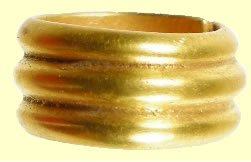
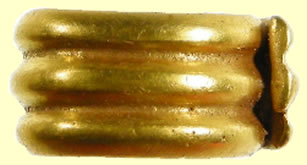
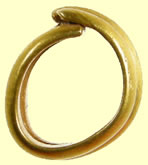
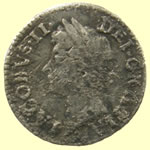
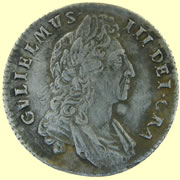
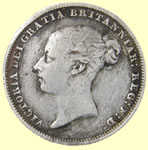
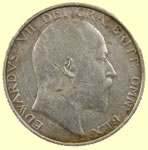

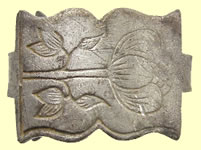
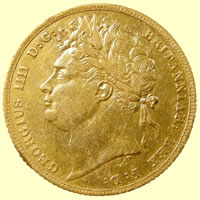
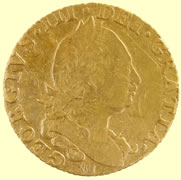

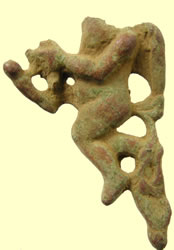
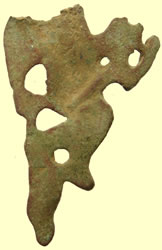
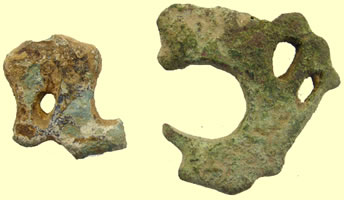
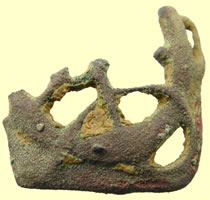
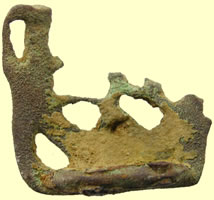
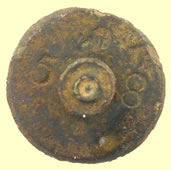
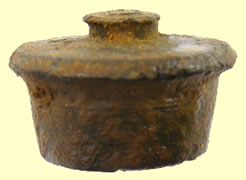

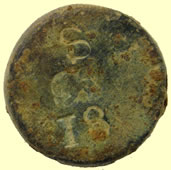
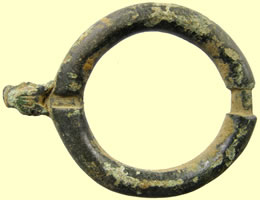
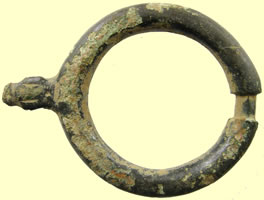
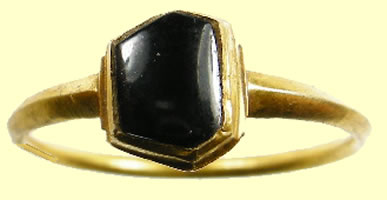
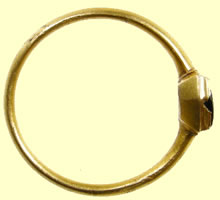
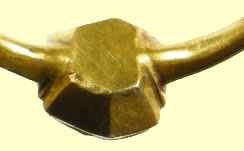
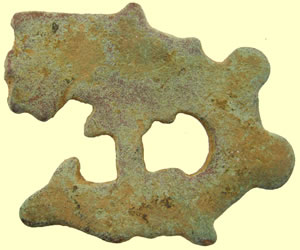
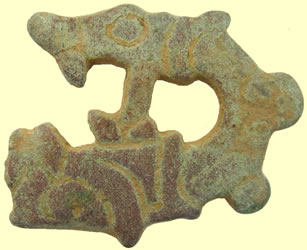
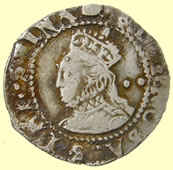

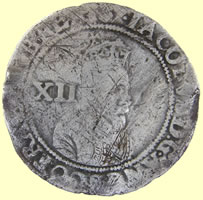
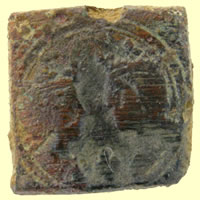

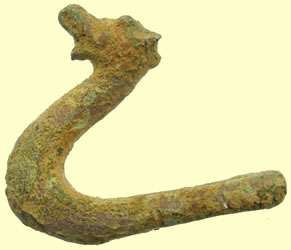
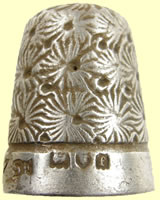
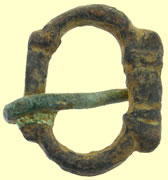
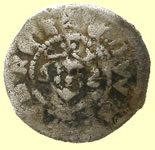
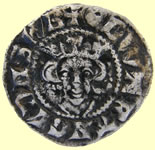
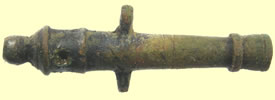
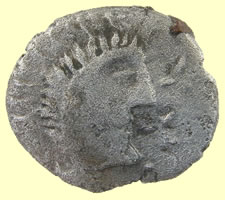
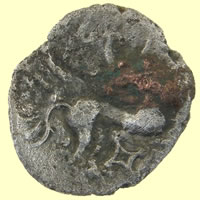
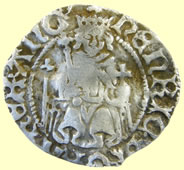
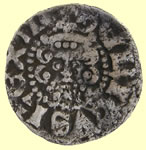
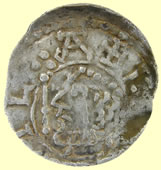
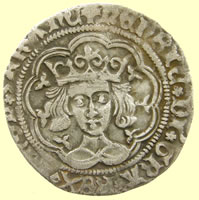
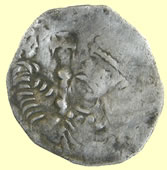
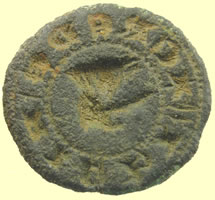
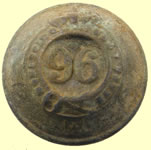
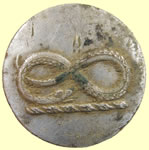
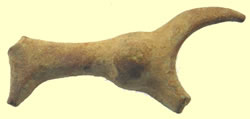




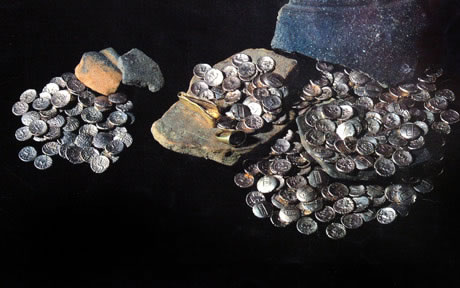
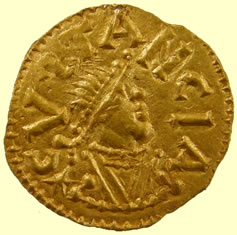
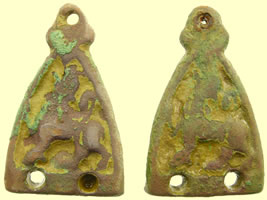


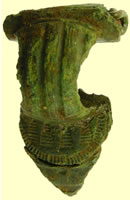

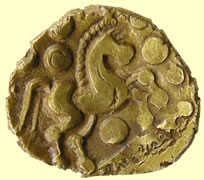
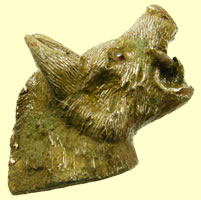
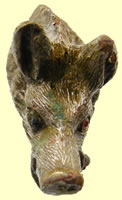
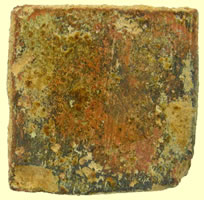


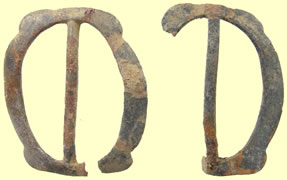

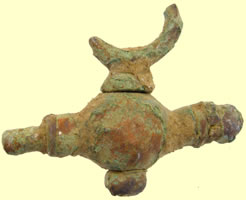
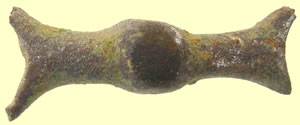
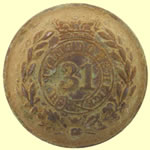
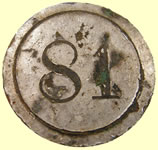
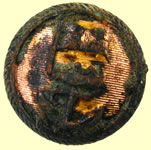
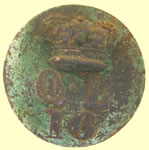
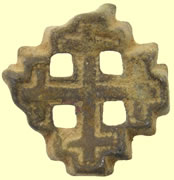
 'A badge for a Knight of the Order of the Holy Sepulchre in bronze and dating somewhere around C13/14th possibly very slightly later . This is a very scarce item and it relates to The Equestrian Order of the Holy Sepulchre of Jerusalem being a Catholic chivalric order of Knighthood that traces its roots to Godfrey of Bouillon, principal leader of the First Crusade. According to reliable sources in the Vatican and Jerusalem, it began in historical reality as a mixed clerical and lay confraternity (association) of pilgrims which gradually grew around the most central of the Christian holy places in the Middle East, the Holy Sepulchre or the tomb of Jesus Christ.This would have been a pin for a member of the order , there is a mark on the reverse where the original pin would have been fixed '
'A badge for a Knight of the Order of the Holy Sepulchre in bronze and dating somewhere around C13/14th possibly very slightly later . This is a very scarce item and it relates to The Equestrian Order of the Holy Sepulchre of Jerusalem being a Catholic chivalric order of Knighthood that traces its roots to Godfrey of Bouillon, principal leader of the First Crusade. According to reliable sources in the Vatican and Jerusalem, it began in historical reality as a mixed clerical and lay confraternity (association) of pilgrims which gradually grew around the most central of the Christian holy places in the Middle East, the Holy Sepulchre or the tomb of Jesus Christ.This would have been a pin for a member of the order , there is a mark on the reverse where the original pin would have been fixed '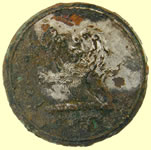
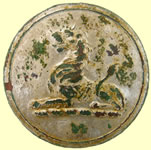
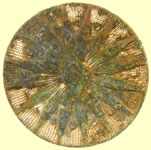
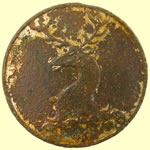
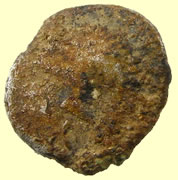
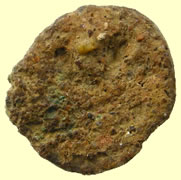


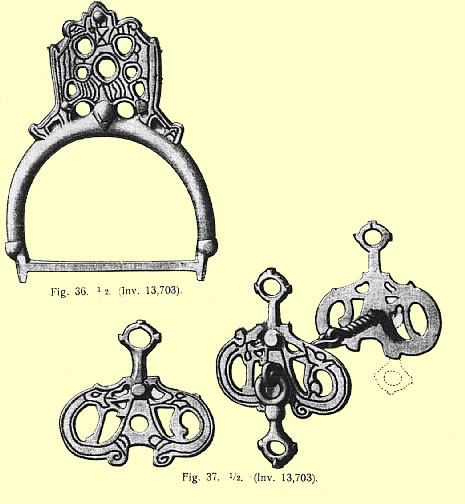


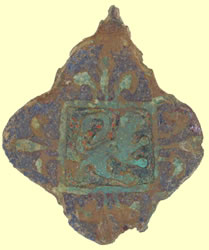
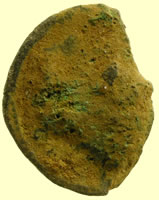
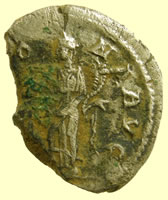


.jpg)
.jpg)
.jpg)
